Apollo 13: Analysis of NASA Mission Control and Spacecraft Performance
VerifiedAdded on 2023/04/23
|23
|6291
|333
Report
AI Summary
This report provides a comprehensive analysis of the performance of NASA's Mission Control and the spacecraft during the Apollo 13 mission. It begins with an executive summary outlining the key findings and the application of the Nadler-Tushman congruence model as a diagnostic tool. The introduction details the mission's context, including the technical failure and the successful handling of the crisis. The report then delves into the Nadler-Tushman model, explaining its components and application to the Apollo 13 case, highlighting the fit between work, culture, people, and structure within NASA. Data sources, including the Apollo 13 movie and various NASA articles, are discussed. A situational overview, including internal and external environment analyses, is presented using SWOT and PESTLE analyses to identify strengths, weaknesses, opportunities, and threats, as well as political, economic, social, technological, legal, and environmental factors. The report concludes with a root cause analysis using Fishbone diagrams and Forcefield Analysis, and provides recommendations for improvement.
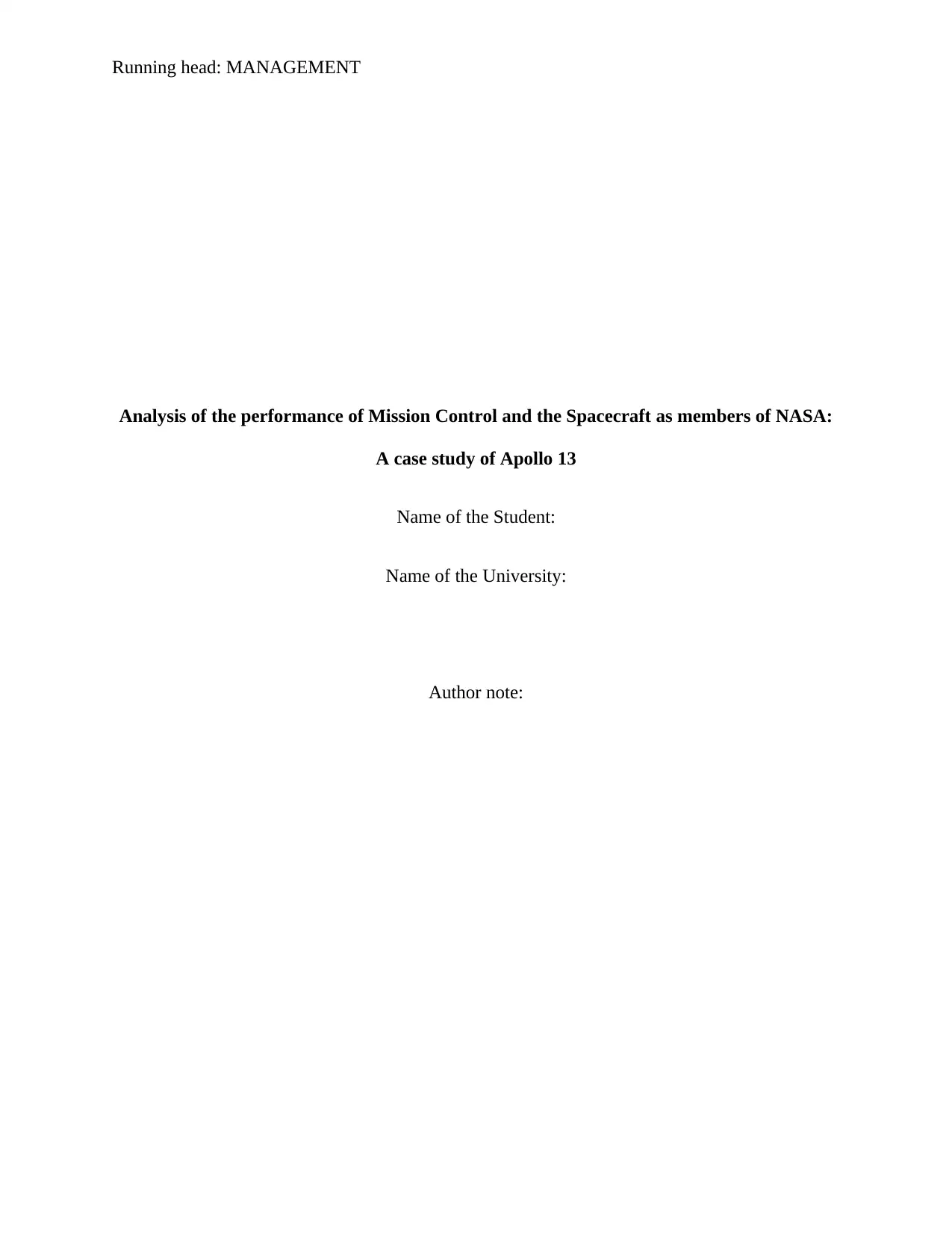
Running head: MANAGEMENT
Analysis of the performance of Mission Control and the Spacecraft as members of NASA:
A case study of Apollo 13
Name of the Student:
Name of the University:
Author note:
Analysis of the performance of Mission Control and the Spacecraft as members of NASA:
A case study of Apollo 13
Name of the Student:
Name of the University:
Author note:
Secure Best Marks with AI Grader
Need help grading? Try our AI Grader for instant feedback on your assignments.
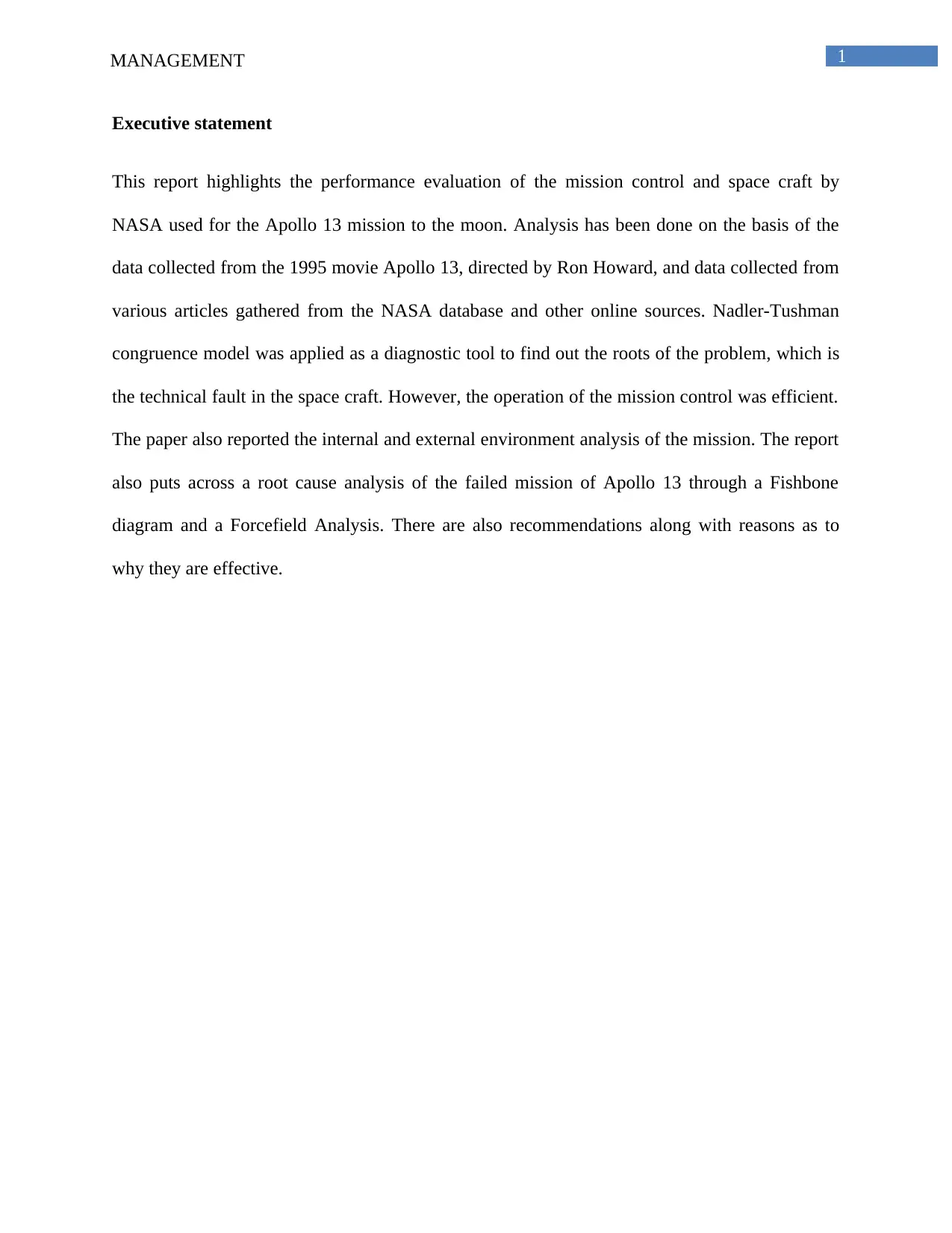
1MANAGEMENT
Executive statement
This report highlights the performance evaluation of the mission control and space craft by
NASA used for the Apollo 13 mission to the moon. Analysis has been done on the basis of the
data collected from the 1995 movie Apollo 13, directed by Ron Howard, and data collected from
various articles gathered from the NASA database and other online sources. Nadler-Tushman
congruence model was applied as a diagnostic tool to find out the roots of the problem, which is
the technical fault in the space craft. However, the operation of the mission control was efficient.
The paper also reported the internal and external environment analysis of the mission. The report
also puts across a root cause analysis of the failed mission of Apollo 13 through a Fishbone
diagram and a Forcefield Analysis. There are also recommendations along with reasons as to
why they are effective.
Executive statement
This report highlights the performance evaluation of the mission control and space craft by
NASA used for the Apollo 13 mission to the moon. Analysis has been done on the basis of the
data collected from the 1995 movie Apollo 13, directed by Ron Howard, and data collected from
various articles gathered from the NASA database and other online sources. Nadler-Tushman
congruence model was applied as a diagnostic tool to find out the roots of the problem, which is
the technical fault in the space craft. However, the operation of the mission control was efficient.
The paper also reported the internal and external environment analysis of the mission. The report
also puts across a root cause analysis of the failed mission of Apollo 13 through a Fishbone
diagram and a Forcefield Analysis. There are also recommendations along with reasons as to
why they are effective.
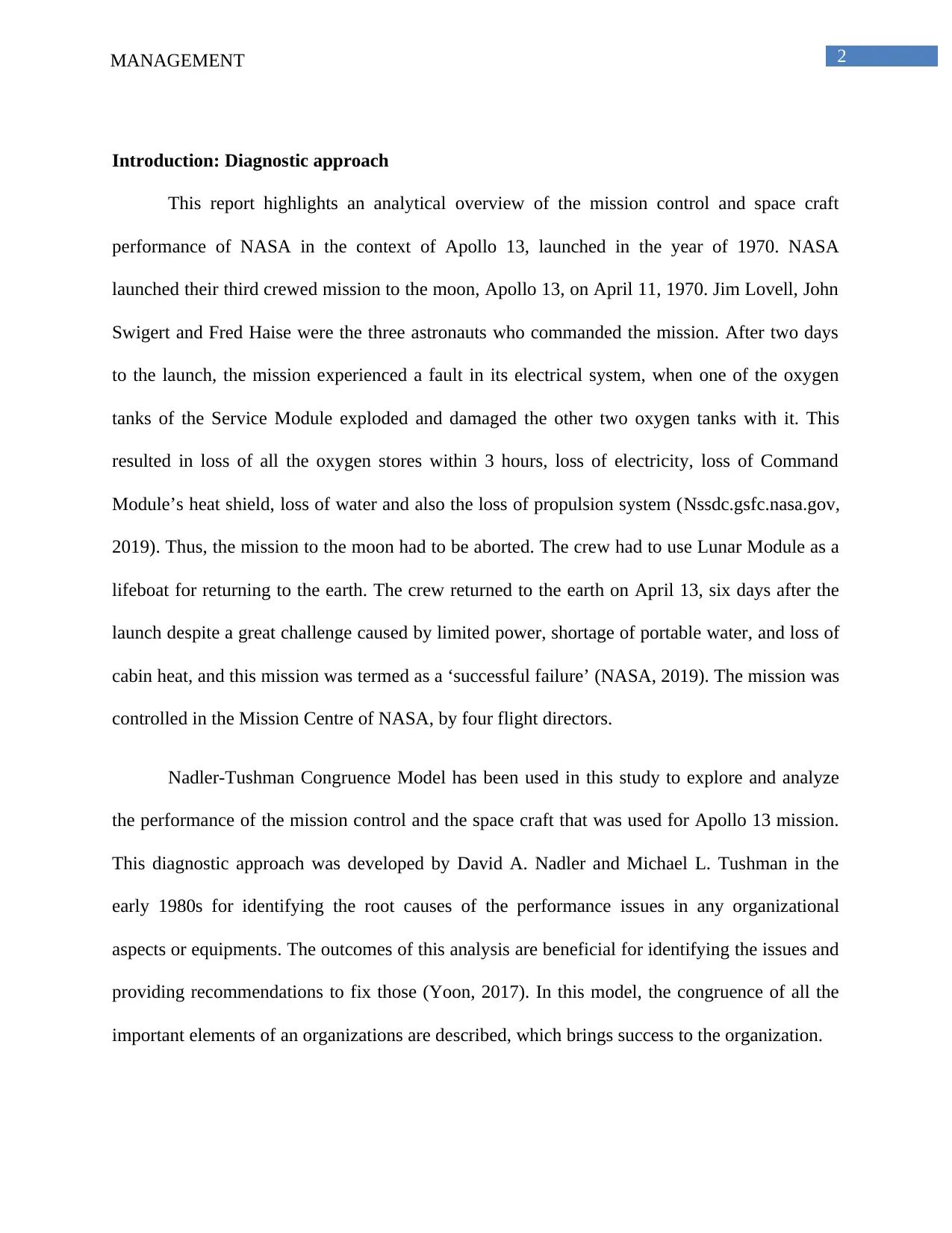
2MANAGEMENT
Introduction: Diagnostic approach
This report highlights an analytical overview of the mission control and space craft
performance of NASA in the context of Apollo 13, launched in the year of 1970. NASA
launched their third crewed mission to the moon, Apollo 13, on April 11, 1970. Jim Lovell, John
Swigert and Fred Haise were the three astronauts who commanded the mission. After two days
to the launch, the mission experienced a fault in its electrical system, when one of the oxygen
tanks of the Service Module exploded and damaged the other two oxygen tanks with it. This
resulted in loss of all the oxygen stores within 3 hours, loss of electricity, loss of Command
Module’s heat shield, loss of water and also the loss of propulsion system (Nssdc.gsfc.nasa.gov,
2019). Thus, the mission to the moon had to be aborted. The crew had to use Lunar Module as a
lifeboat for returning to the earth. The crew returned to the earth on April 13, six days after the
launch despite a great challenge caused by limited power, shortage of portable water, and loss of
cabin heat, and this mission was termed as a ‘successful failure’ (NASA, 2019). The mission was
controlled in the Mission Centre of NASA, by four flight directors.
Nadler-Tushman Congruence Model has been used in this study to explore and analyze
the performance of the mission control and the space craft that was used for Apollo 13 mission.
This diagnostic approach was developed by David A. Nadler and Michael L. Tushman in the
early 1980s for identifying the root causes of the performance issues in any organizational
aspects or equipments. The outcomes of this analysis are beneficial for identifying the issues and
providing recommendations to fix those (Yoon, 2017). In this model, the congruence of all the
important elements of an organizations are described, which brings success to the organization.
Introduction: Diagnostic approach
This report highlights an analytical overview of the mission control and space craft
performance of NASA in the context of Apollo 13, launched in the year of 1970. NASA
launched their third crewed mission to the moon, Apollo 13, on April 11, 1970. Jim Lovell, John
Swigert and Fred Haise were the three astronauts who commanded the mission. After two days
to the launch, the mission experienced a fault in its electrical system, when one of the oxygen
tanks of the Service Module exploded and damaged the other two oxygen tanks with it. This
resulted in loss of all the oxygen stores within 3 hours, loss of electricity, loss of Command
Module’s heat shield, loss of water and also the loss of propulsion system (Nssdc.gsfc.nasa.gov,
2019). Thus, the mission to the moon had to be aborted. The crew had to use Lunar Module as a
lifeboat for returning to the earth. The crew returned to the earth on April 13, six days after the
launch despite a great challenge caused by limited power, shortage of portable water, and loss of
cabin heat, and this mission was termed as a ‘successful failure’ (NASA, 2019). The mission was
controlled in the Mission Centre of NASA, by four flight directors.
Nadler-Tushman Congruence Model has been used in this study to explore and analyze
the performance of the mission control and the space craft that was used for Apollo 13 mission.
This diagnostic approach was developed by David A. Nadler and Michael L. Tushman in the
early 1980s for identifying the root causes of the performance issues in any organizational
aspects or equipments. The outcomes of this analysis are beneficial for identifying the issues and
providing recommendations to fix those (Yoon, 2017). In this model, the congruence of all the
important elements of an organizations are described, which brings success to the organization.
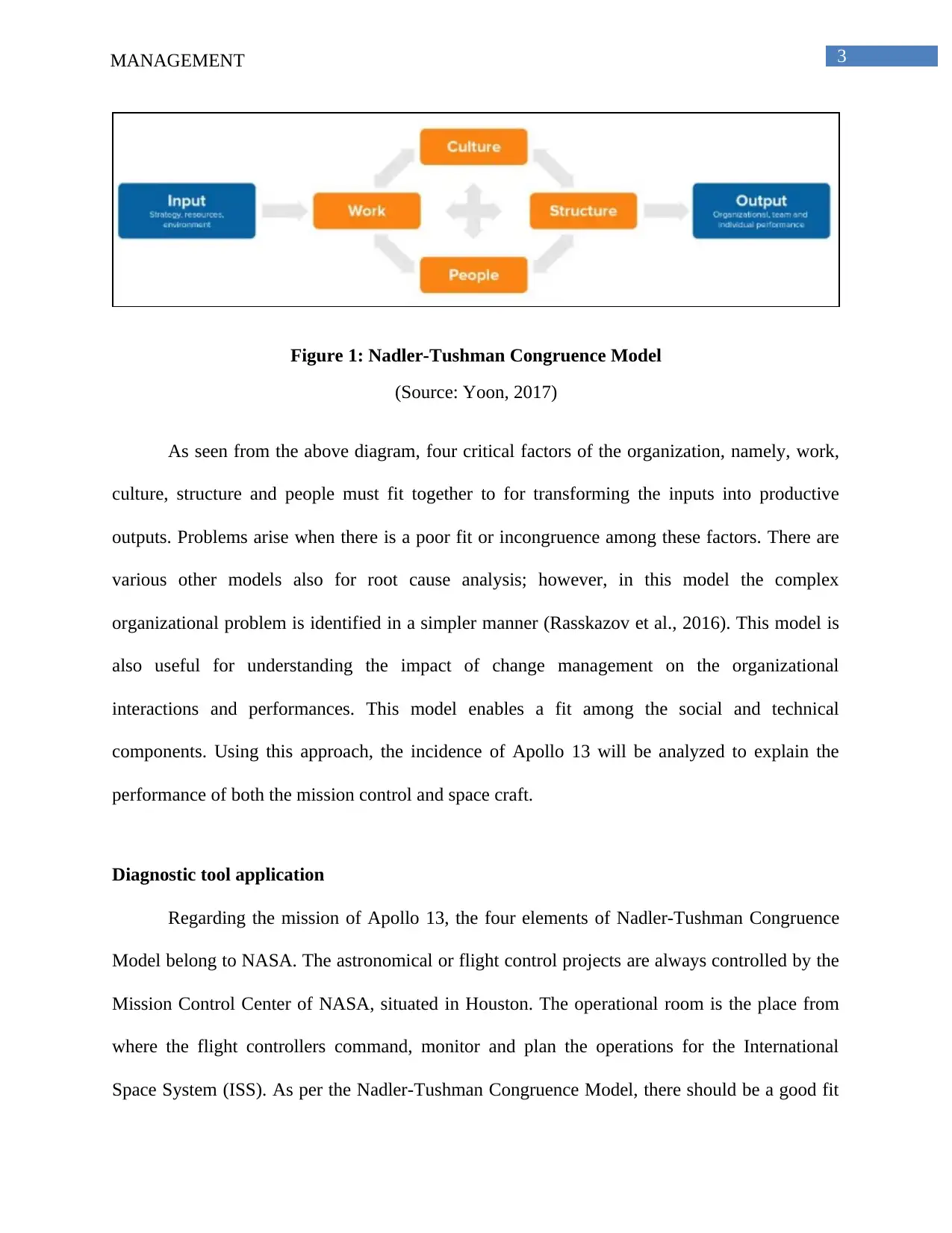
3MANAGEMENT
Figure 1: Nadler-Tushman Congruence Model
(Source: Yoon, 2017)
As seen from the above diagram, four critical factors of the organization, namely, work,
culture, structure and people must fit together to for transforming the inputs into productive
outputs. Problems arise when there is a poor fit or incongruence among these factors. There are
various other models also for root cause analysis; however, in this model the complex
organizational problem is identified in a simpler manner (Rasskazov et al., 2016). This model is
also useful for understanding the impact of change management on the organizational
interactions and performances. This model enables a fit among the social and technical
components. Using this approach, the incidence of Apollo 13 will be analyzed to explain the
performance of both the mission control and space craft.
Diagnostic tool application
Regarding the mission of Apollo 13, the four elements of Nadler-Tushman Congruence
Model belong to NASA. The astronomical or flight control projects are always controlled by the
Mission Control Center of NASA, situated in Houston. The operational room is the place from
where the flight controllers command, monitor and plan the operations for the International
Space System (ISS). As per the Nadler-Tushman Congruence Model, there should be a good fit
Figure 1: Nadler-Tushman Congruence Model
(Source: Yoon, 2017)
As seen from the above diagram, four critical factors of the organization, namely, work,
culture, structure and people must fit together to for transforming the inputs into productive
outputs. Problems arise when there is a poor fit or incongruence among these factors. There are
various other models also for root cause analysis; however, in this model the complex
organizational problem is identified in a simpler manner (Rasskazov et al., 2016). This model is
also useful for understanding the impact of change management on the organizational
interactions and performances. This model enables a fit among the social and technical
components. Using this approach, the incidence of Apollo 13 will be analyzed to explain the
performance of both the mission control and space craft.
Diagnostic tool application
Regarding the mission of Apollo 13, the four elements of Nadler-Tushman Congruence
Model belong to NASA. The astronomical or flight control projects are always controlled by the
Mission Control Center of NASA, situated in Houston. The operational room is the place from
where the flight controllers command, monitor and plan the operations for the International
Space System (ISS). As per the Nadler-Tushman Congruence Model, there should be a good fit
Secure Best Marks with AI Grader
Need help grading? Try our AI Grader for instant feedback on your assignments.
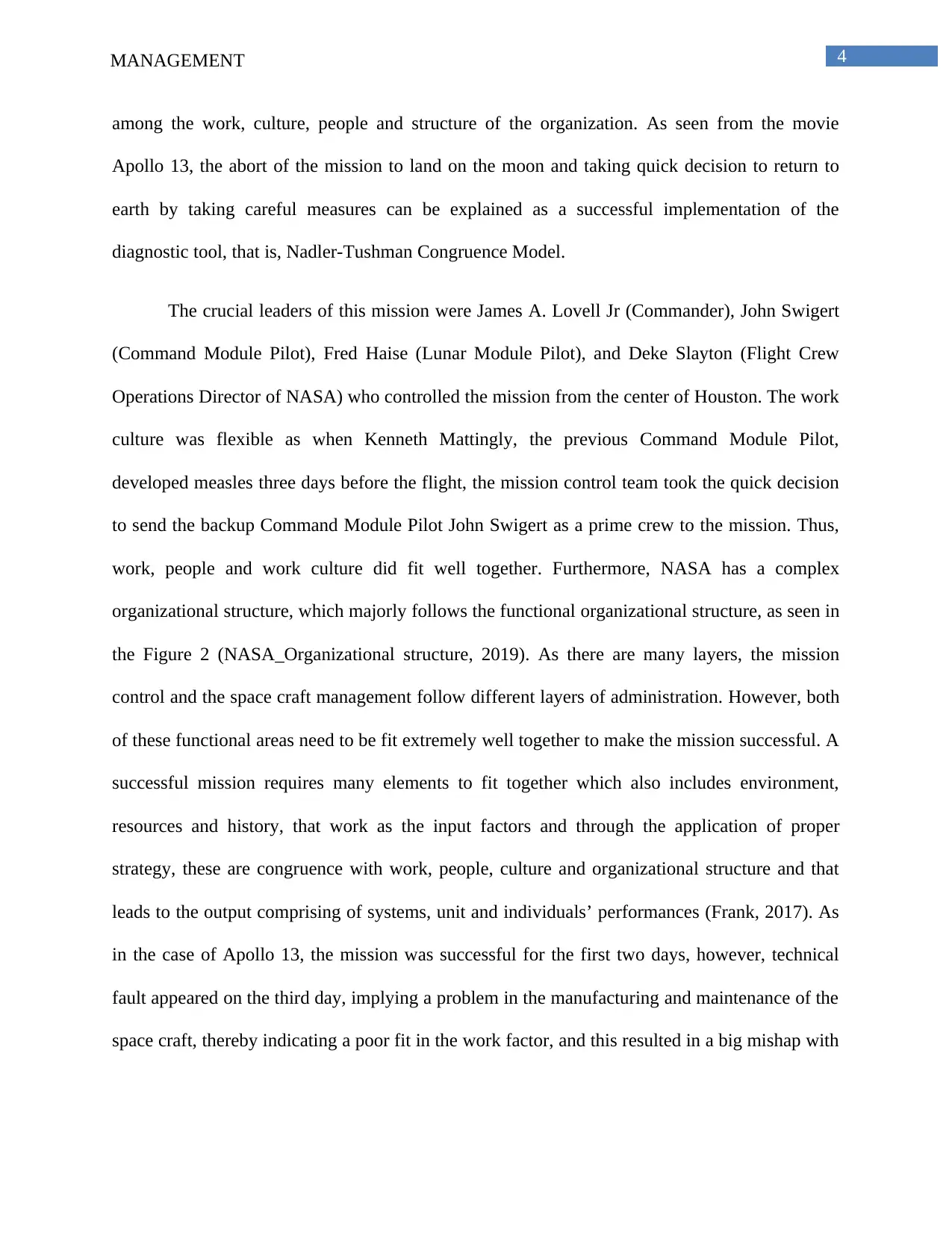
4MANAGEMENT
among the work, culture, people and structure of the organization. As seen from the movie
Apollo 13, the abort of the mission to land on the moon and taking quick decision to return to
earth by taking careful measures can be explained as a successful implementation of the
diagnostic tool, that is, Nadler-Tushman Congruence Model.
The crucial leaders of this mission were James A. Lovell Jr (Commander), John Swigert
(Command Module Pilot), Fred Haise (Lunar Module Pilot), and Deke Slayton (Flight Crew
Operations Director of NASA) who controlled the mission from the center of Houston. The work
culture was flexible as when Kenneth Mattingly, the previous Command Module Pilot,
developed measles three days before the flight, the mission control team took the quick decision
to send the backup Command Module Pilot John Swigert as a prime crew to the mission. Thus,
work, people and work culture did fit well together. Furthermore, NASA has a complex
organizational structure, which majorly follows the functional organizational structure, as seen in
the Figure 2 (NASA_Organizational structure, 2019). As there are many layers, the mission
control and the space craft management follow different layers of administration. However, both
of these functional areas need to be fit extremely well together to make the mission successful. A
successful mission requires many elements to fit together which also includes environment,
resources and history, that work as the input factors and through the application of proper
strategy, these are congruence with work, people, culture and organizational structure and that
leads to the output comprising of systems, unit and individuals’ performances (Frank, 2017). As
in the case of Apollo 13, the mission was successful for the first two days, however, technical
fault appeared on the third day, implying a problem in the manufacturing and maintenance of the
space craft, thereby indicating a poor fit in the work factor, and this resulted in a big mishap with
among the work, culture, people and structure of the organization. As seen from the movie
Apollo 13, the abort of the mission to land on the moon and taking quick decision to return to
earth by taking careful measures can be explained as a successful implementation of the
diagnostic tool, that is, Nadler-Tushman Congruence Model.
The crucial leaders of this mission were James A. Lovell Jr (Commander), John Swigert
(Command Module Pilot), Fred Haise (Lunar Module Pilot), and Deke Slayton (Flight Crew
Operations Director of NASA) who controlled the mission from the center of Houston. The work
culture was flexible as when Kenneth Mattingly, the previous Command Module Pilot,
developed measles three days before the flight, the mission control team took the quick decision
to send the backup Command Module Pilot John Swigert as a prime crew to the mission. Thus,
work, people and work culture did fit well together. Furthermore, NASA has a complex
organizational structure, which majorly follows the functional organizational structure, as seen in
the Figure 2 (NASA_Organizational structure, 2019). As there are many layers, the mission
control and the space craft management follow different layers of administration. However, both
of these functional areas need to be fit extremely well together to make the mission successful. A
successful mission requires many elements to fit together which also includes environment,
resources and history, that work as the input factors and through the application of proper
strategy, these are congruence with work, people, culture and organizational structure and that
leads to the output comprising of systems, unit and individuals’ performances (Frank, 2017). As
in the case of Apollo 13, the mission was successful for the first two days, however, technical
fault appeared on the third day, implying a problem in the manufacturing and maintenance of the
space craft, thereby indicating a poor fit in the work factor, and this resulted in a big mishap with
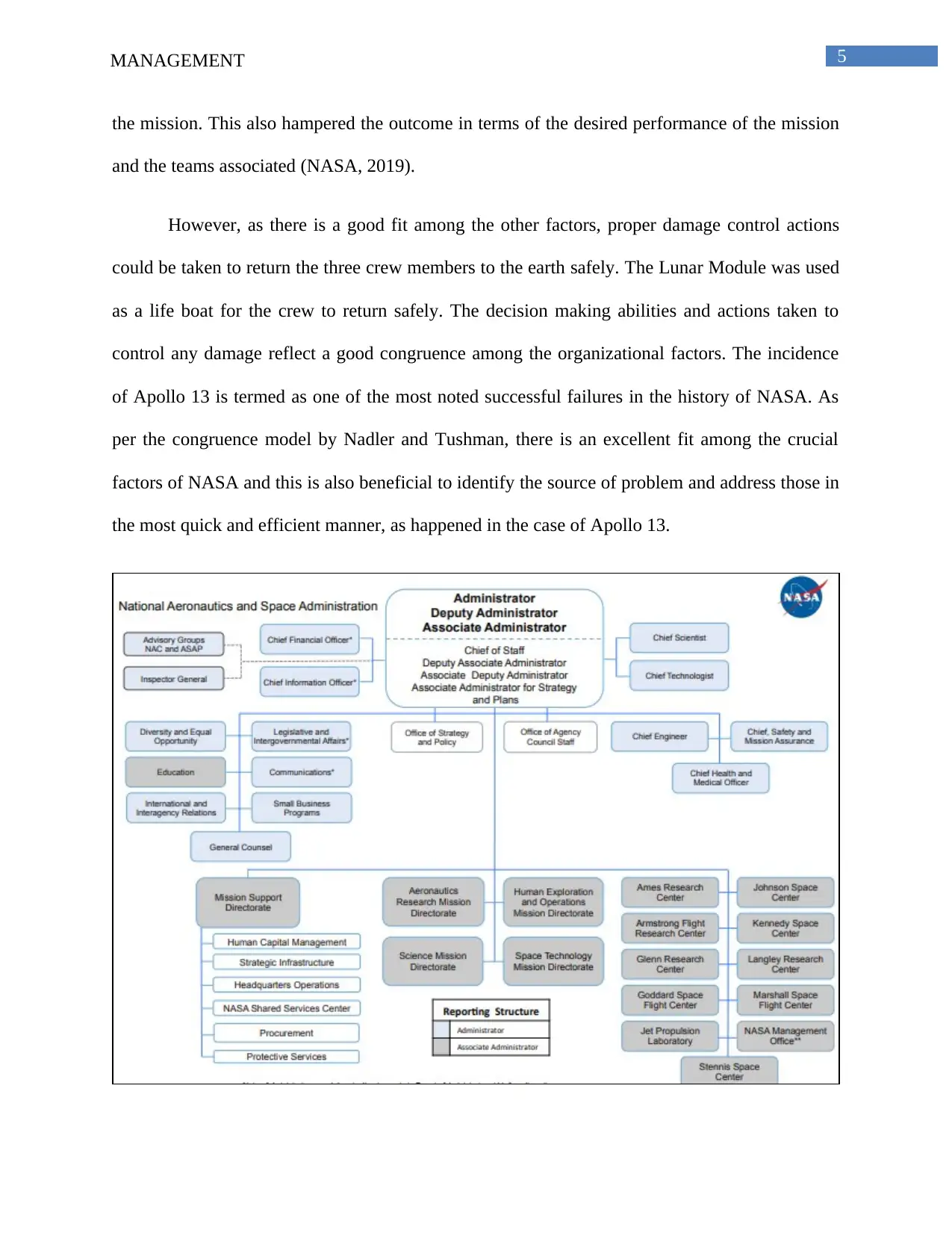
5MANAGEMENT
the mission. This also hampered the outcome in terms of the desired performance of the mission
and the teams associated (NASA, 2019).
However, as there is a good fit among the other factors, proper damage control actions
could be taken to return the three crew members to the earth safely. The Lunar Module was used
as a life boat for the crew to return safely. The decision making abilities and actions taken to
control any damage reflect a good congruence among the organizational factors. The incidence
of Apollo 13 is termed as one of the most noted successful failures in the history of NASA. As
per the congruence model by Nadler and Tushman, there is an excellent fit among the crucial
factors of NASA and this is also beneficial to identify the source of problem and address those in
the most quick and efficient manner, as happened in the case of Apollo 13.
the mission. This also hampered the outcome in terms of the desired performance of the mission
and the teams associated (NASA, 2019).
However, as there is a good fit among the other factors, proper damage control actions
could be taken to return the three crew members to the earth safely. The Lunar Module was used
as a life boat for the crew to return safely. The decision making abilities and actions taken to
control any damage reflect a good congruence among the organizational factors. The incidence
of Apollo 13 is termed as one of the most noted successful failures in the history of NASA. As
per the congruence model by Nadler and Tushman, there is an excellent fit among the crucial
factors of NASA and this is also beneficial to identify the source of problem and address those in
the most quick and efficient manner, as happened in the case of Apollo 13.
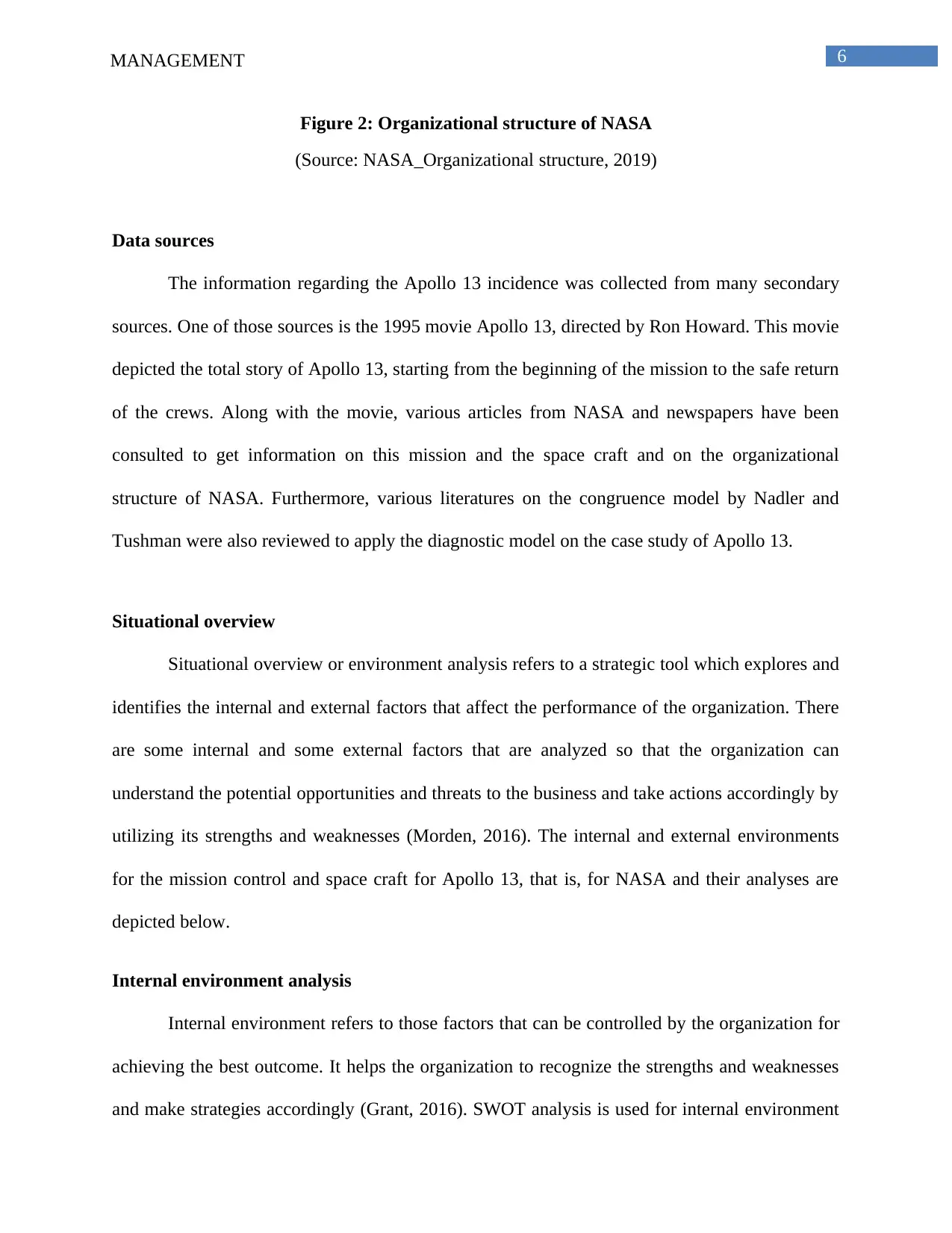
6MANAGEMENT
Figure 2: Organizational structure of NASA
(Source: NASA_Organizational structure, 2019)
Data sources
The information regarding the Apollo 13 incidence was collected from many secondary
sources. One of those sources is the 1995 movie Apollo 13, directed by Ron Howard. This movie
depicted the total story of Apollo 13, starting from the beginning of the mission to the safe return
of the crews. Along with the movie, various articles from NASA and newspapers have been
consulted to get information on this mission and the space craft and on the organizational
structure of NASA. Furthermore, various literatures on the congruence model by Nadler and
Tushman were also reviewed to apply the diagnostic model on the case study of Apollo 13.
Situational overview
Situational overview or environment analysis refers to a strategic tool which explores and
identifies the internal and external factors that affect the performance of the organization. There
are some internal and some external factors that are analyzed so that the organization can
understand the potential opportunities and threats to the business and take actions accordingly by
utilizing its strengths and weaknesses (Morden, 2016). The internal and external environments
for the mission control and space craft for Apollo 13, that is, for NASA and their analyses are
depicted below.
Internal environment analysis
Internal environment refers to those factors that can be controlled by the organization for
achieving the best outcome. It helps the organization to recognize the strengths and weaknesses
and make strategies accordingly (Grant, 2016). SWOT analysis is used for internal environment
Figure 2: Organizational structure of NASA
(Source: NASA_Organizational structure, 2019)
Data sources
The information regarding the Apollo 13 incidence was collected from many secondary
sources. One of those sources is the 1995 movie Apollo 13, directed by Ron Howard. This movie
depicted the total story of Apollo 13, starting from the beginning of the mission to the safe return
of the crews. Along with the movie, various articles from NASA and newspapers have been
consulted to get information on this mission and the space craft and on the organizational
structure of NASA. Furthermore, various literatures on the congruence model by Nadler and
Tushman were also reviewed to apply the diagnostic model on the case study of Apollo 13.
Situational overview
Situational overview or environment analysis refers to a strategic tool which explores and
identifies the internal and external factors that affect the performance of the organization. There
are some internal and some external factors that are analyzed so that the organization can
understand the potential opportunities and threats to the business and take actions accordingly by
utilizing its strengths and weaknesses (Morden, 2016). The internal and external environments
for the mission control and space craft for Apollo 13, that is, for NASA and their analyses are
depicted below.
Internal environment analysis
Internal environment refers to those factors that can be controlled by the organization for
achieving the best outcome. It helps the organization to recognize the strengths and weaknesses
and make strategies accordingly (Grant, 2016). SWOT analysis is used for internal environment
Paraphrase This Document
Need a fresh take? Get an instant paraphrase of this document with our AI Paraphraser
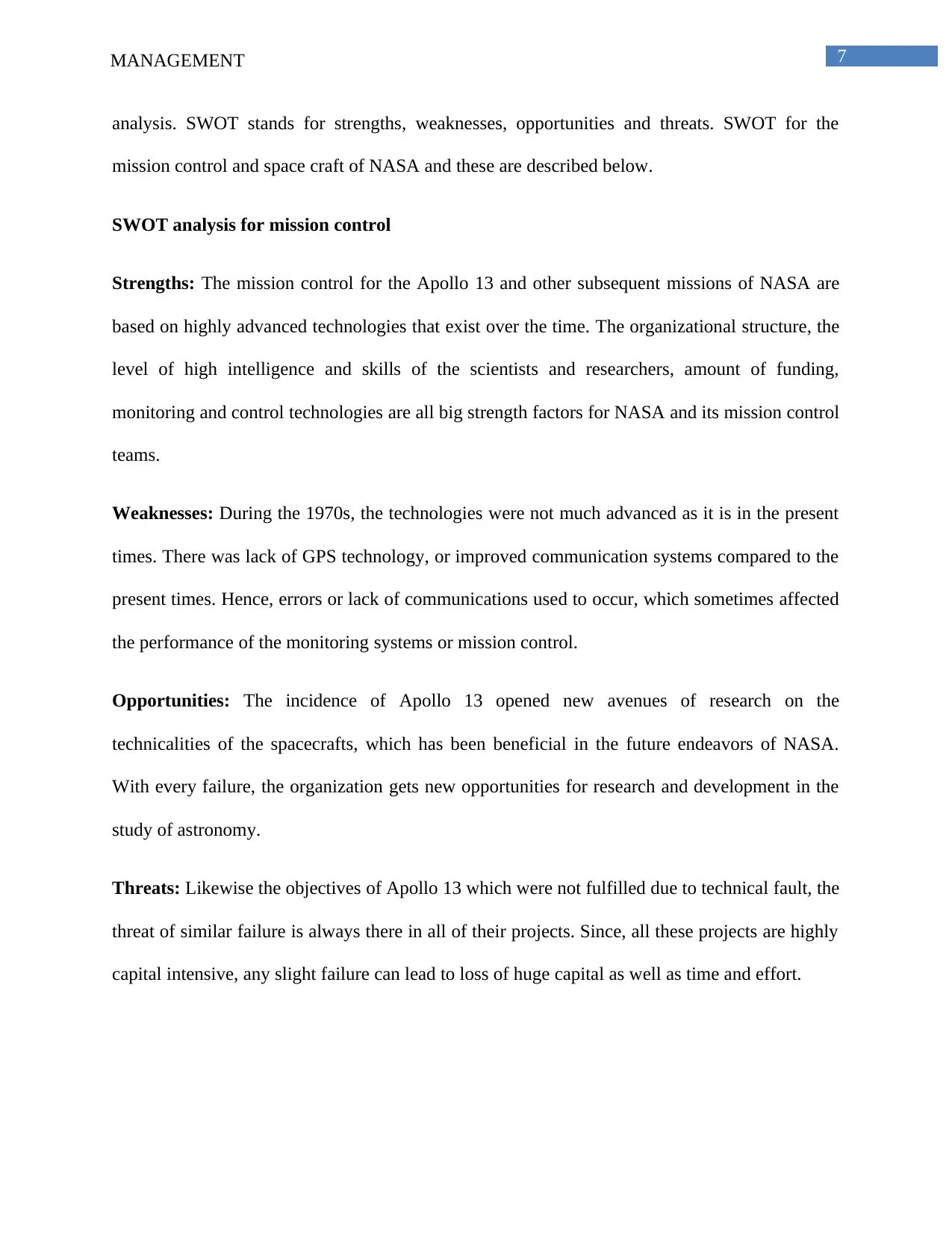
7MANAGEMENT
analysis. SWOT stands for strengths, weaknesses, opportunities and threats. SWOT for the
mission control and space craft of NASA and these are described below.
SWOT analysis for mission control
Strengths: The mission control for the Apollo 13 and other subsequent missions of NASA are
based on highly advanced technologies that exist over the time. The organizational structure, the
level of high intelligence and skills of the scientists and researchers, amount of funding,
monitoring and control technologies are all big strength factors for NASA and its mission control
teams.
Weaknesses: During the 1970s, the technologies were not much advanced as it is in the present
times. There was lack of GPS technology, or improved communication systems compared to the
present times. Hence, errors or lack of communications used to occur, which sometimes affected
the performance of the monitoring systems or mission control.
Opportunities: The incidence of Apollo 13 opened new avenues of research on the
technicalities of the spacecrafts, which has been beneficial in the future endeavors of NASA.
With every failure, the organization gets new opportunities for research and development in the
study of astronomy.
Threats: Likewise the objectives of Apollo 13 which were not fulfilled due to technical fault, the
threat of similar failure is always there in all of their projects. Since, all these projects are highly
capital intensive, any slight failure can lead to loss of huge capital as well as time and effort.
analysis. SWOT stands for strengths, weaknesses, opportunities and threats. SWOT for the
mission control and space craft of NASA and these are described below.
SWOT analysis for mission control
Strengths: The mission control for the Apollo 13 and other subsequent missions of NASA are
based on highly advanced technologies that exist over the time. The organizational structure, the
level of high intelligence and skills of the scientists and researchers, amount of funding,
monitoring and control technologies are all big strength factors for NASA and its mission control
teams.
Weaknesses: During the 1970s, the technologies were not much advanced as it is in the present
times. There was lack of GPS technology, or improved communication systems compared to the
present times. Hence, errors or lack of communications used to occur, which sometimes affected
the performance of the monitoring systems or mission control.
Opportunities: The incidence of Apollo 13 opened new avenues of research on the
technicalities of the spacecrafts, which has been beneficial in the future endeavors of NASA.
With every failure, the organization gets new opportunities for research and development in the
study of astronomy.
Threats: Likewise the objectives of Apollo 13 which were not fulfilled due to technical fault, the
threat of similar failure is always there in all of their projects. Since, all these projects are highly
capital intensive, any slight failure can lead to loss of huge capital as well as time and effort.
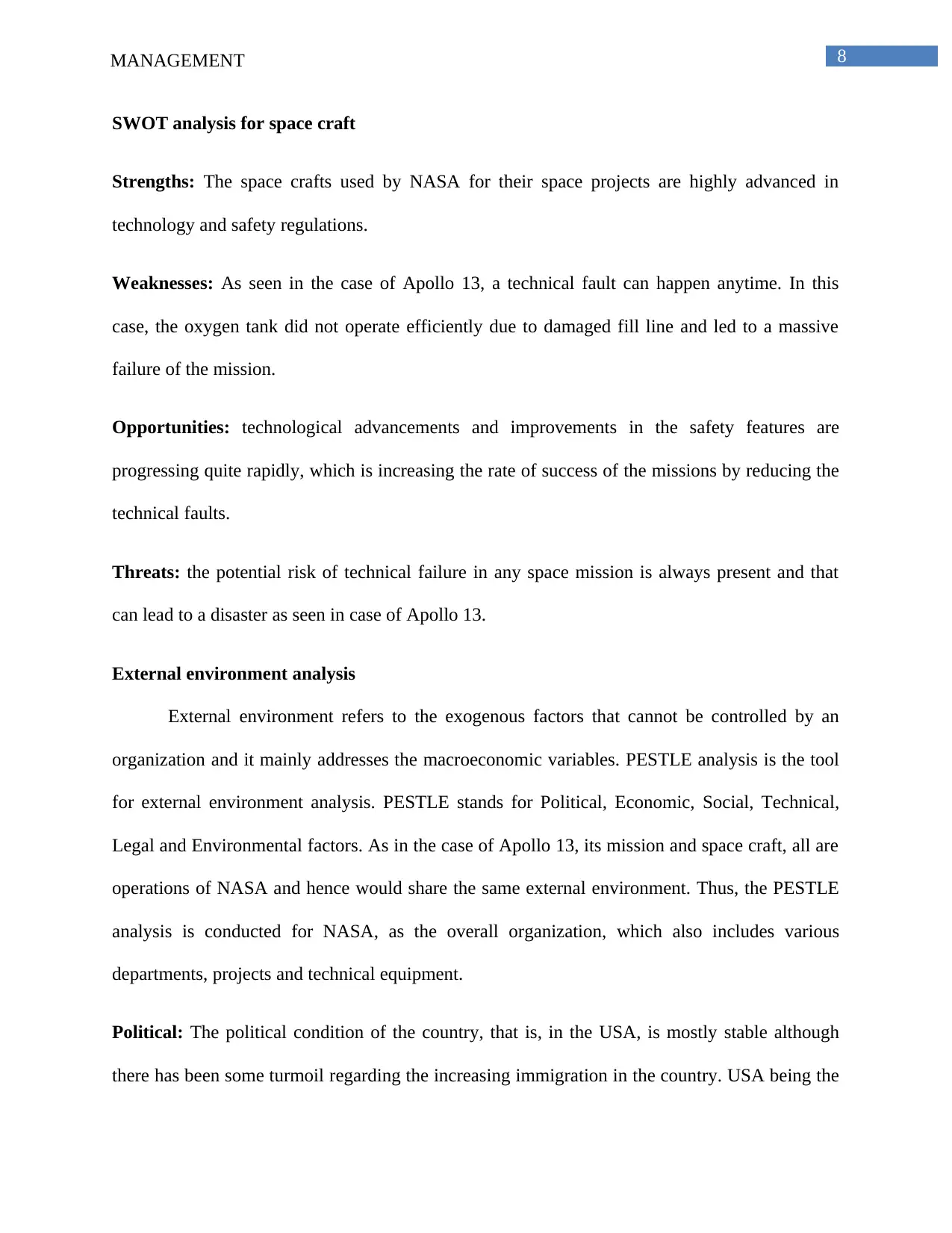
8MANAGEMENT
SWOT analysis for space craft
Strengths: The space crafts used by NASA for their space projects are highly advanced in
technology and safety regulations.
Weaknesses: As seen in the case of Apollo 13, a technical fault can happen anytime. In this
case, the oxygen tank did not operate efficiently due to damaged fill line and led to a massive
failure of the mission.
Opportunities: technological advancements and improvements in the safety features are
progressing quite rapidly, which is increasing the rate of success of the missions by reducing the
technical faults.
Threats: the potential risk of technical failure in any space mission is always present and that
can lead to a disaster as seen in case of Apollo 13.
External environment analysis
External environment refers to the exogenous factors that cannot be controlled by an
organization and it mainly addresses the macroeconomic variables. PESTLE analysis is the tool
for external environment analysis. PESTLE stands for Political, Economic, Social, Technical,
Legal and Environmental factors. As in the case of Apollo 13, its mission and space craft, all are
operations of NASA and hence would share the same external environment. Thus, the PESTLE
analysis is conducted for NASA, as the overall organization, which also includes various
departments, projects and technical equipment.
Political: The political condition of the country, that is, in the USA, is mostly stable although
there has been some turmoil regarding the increasing immigration in the country. USA being the
SWOT analysis for space craft
Strengths: The space crafts used by NASA for their space projects are highly advanced in
technology and safety regulations.
Weaknesses: As seen in the case of Apollo 13, a technical fault can happen anytime. In this
case, the oxygen tank did not operate efficiently due to damaged fill line and led to a massive
failure of the mission.
Opportunities: technological advancements and improvements in the safety features are
progressing quite rapidly, which is increasing the rate of success of the missions by reducing the
technical faults.
Threats: the potential risk of technical failure in any space mission is always present and that
can lead to a disaster as seen in case of Apollo 13.
External environment analysis
External environment refers to the exogenous factors that cannot be controlled by an
organization and it mainly addresses the macroeconomic variables. PESTLE analysis is the tool
for external environment analysis. PESTLE stands for Political, Economic, Social, Technical,
Legal and Environmental factors. As in the case of Apollo 13, its mission and space craft, all are
operations of NASA and hence would share the same external environment. Thus, the PESTLE
analysis is conducted for NASA, as the overall organization, which also includes various
departments, projects and technical equipment.
Political: The political condition of the country, that is, in the USA, is mostly stable although
there has been some turmoil regarding the increasing immigration in the country. USA being the
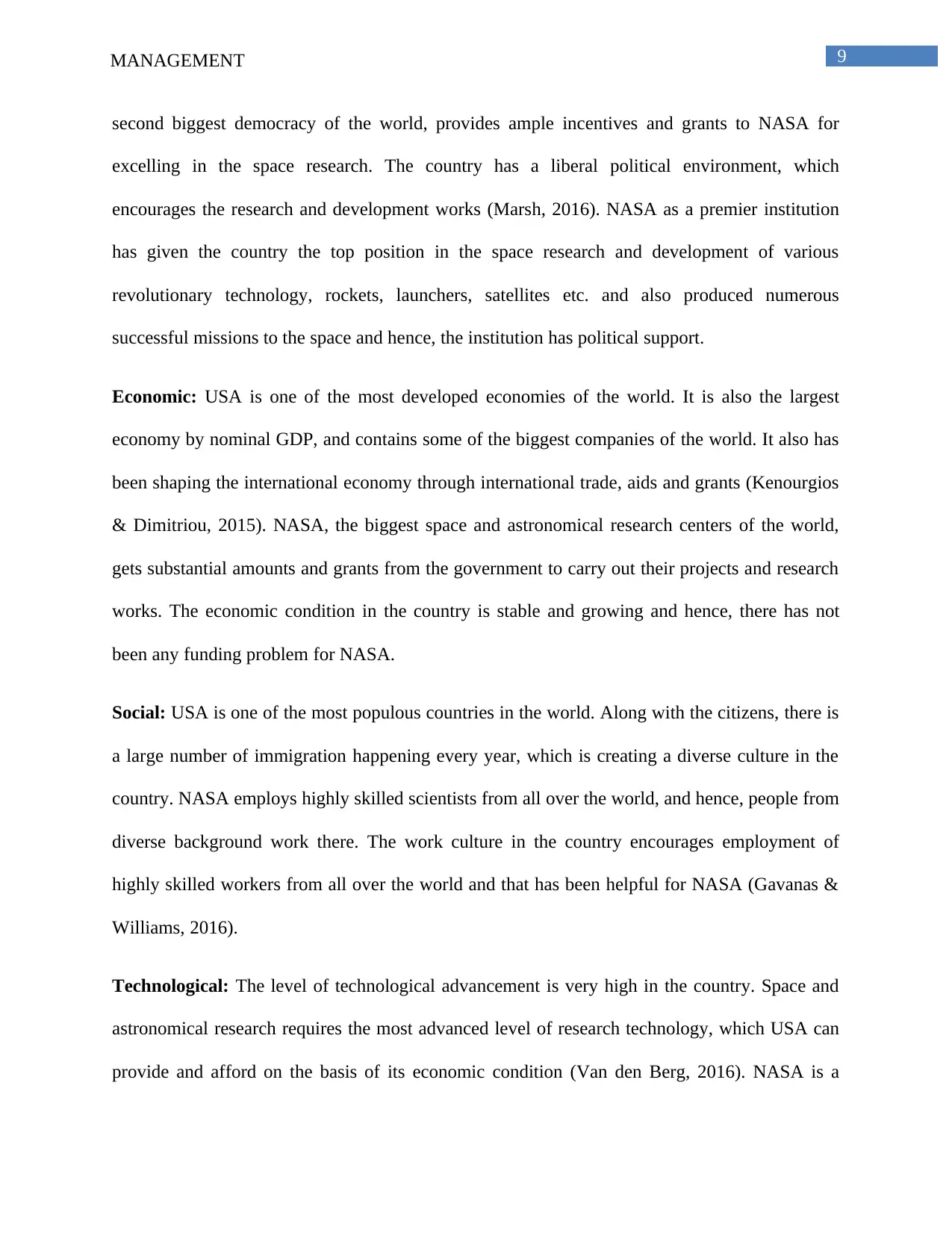
9MANAGEMENT
second biggest democracy of the world, provides ample incentives and grants to NASA for
excelling in the space research. The country has a liberal political environment, which
encourages the research and development works (Marsh, 2016). NASA as a premier institution
has given the country the top position in the space research and development of various
revolutionary technology, rockets, launchers, satellites etc. and also produced numerous
successful missions to the space and hence, the institution has political support.
Economic: USA is one of the most developed economies of the world. It is also the largest
economy by nominal GDP, and contains some of the biggest companies of the world. It also has
been shaping the international economy through international trade, aids and grants (Kenourgios
& Dimitriou, 2015). NASA, the biggest space and astronomical research centers of the world,
gets substantial amounts and grants from the government to carry out their projects and research
works. The economic condition in the country is stable and growing and hence, there has not
been any funding problem for NASA.
Social: USA is one of the most populous countries in the world. Along with the citizens, there is
a large number of immigration happening every year, which is creating a diverse culture in the
country. NASA employs highly skilled scientists from all over the world, and hence, people from
diverse background work there. The work culture in the country encourages employment of
highly skilled workers from all over the world and that has been helpful for NASA (Gavanas &
Williams, 2016).
Technological: The level of technological advancement is very high in the country. Space and
astronomical research requires the most advanced level of research technology, which USA can
provide and afford on the basis of its economic condition (Van den Berg, 2016). NASA is a
second biggest democracy of the world, provides ample incentives and grants to NASA for
excelling in the space research. The country has a liberal political environment, which
encourages the research and development works (Marsh, 2016). NASA as a premier institution
has given the country the top position in the space research and development of various
revolutionary technology, rockets, launchers, satellites etc. and also produced numerous
successful missions to the space and hence, the institution has political support.
Economic: USA is one of the most developed economies of the world. It is also the largest
economy by nominal GDP, and contains some of the biggest companies of the world. It also has
been shaping the international economy through international trade, aids and grants (Kenourgios
& Dimitriou, 2015). NASA, the biggest space and astronomical research centers of the world,
gets substantial amounts and grants from the government to carry out their projects and research
works. The economic condition in the country is stable and growing and hence, there has not
been any funding problem for NASA.
Social: USA is one of the most populous countries in the world. Along with the citizens, there is
a large number of immigration happening every year, which is creating a diverse culture in the
country. NASA employs highly skilled scientists from all over the world, and hence, people from
diverse background work there. The work culture in the country encourages employment of
highly skilled workers from all over the world and that has been helpful for NASA (Gavanas &
Williams, 2016).
Technological: The level of technological advancement is very high in the country. Space and
astronomical research requires the most advanced level of research technology, which USA can
provide and afford on the basis of its economic condition (Van den Berg, 2016). NASA is a
Secure Best Marks with AI Grader
Need help grading? Try our AI Grader for instant feedback on your assignments.
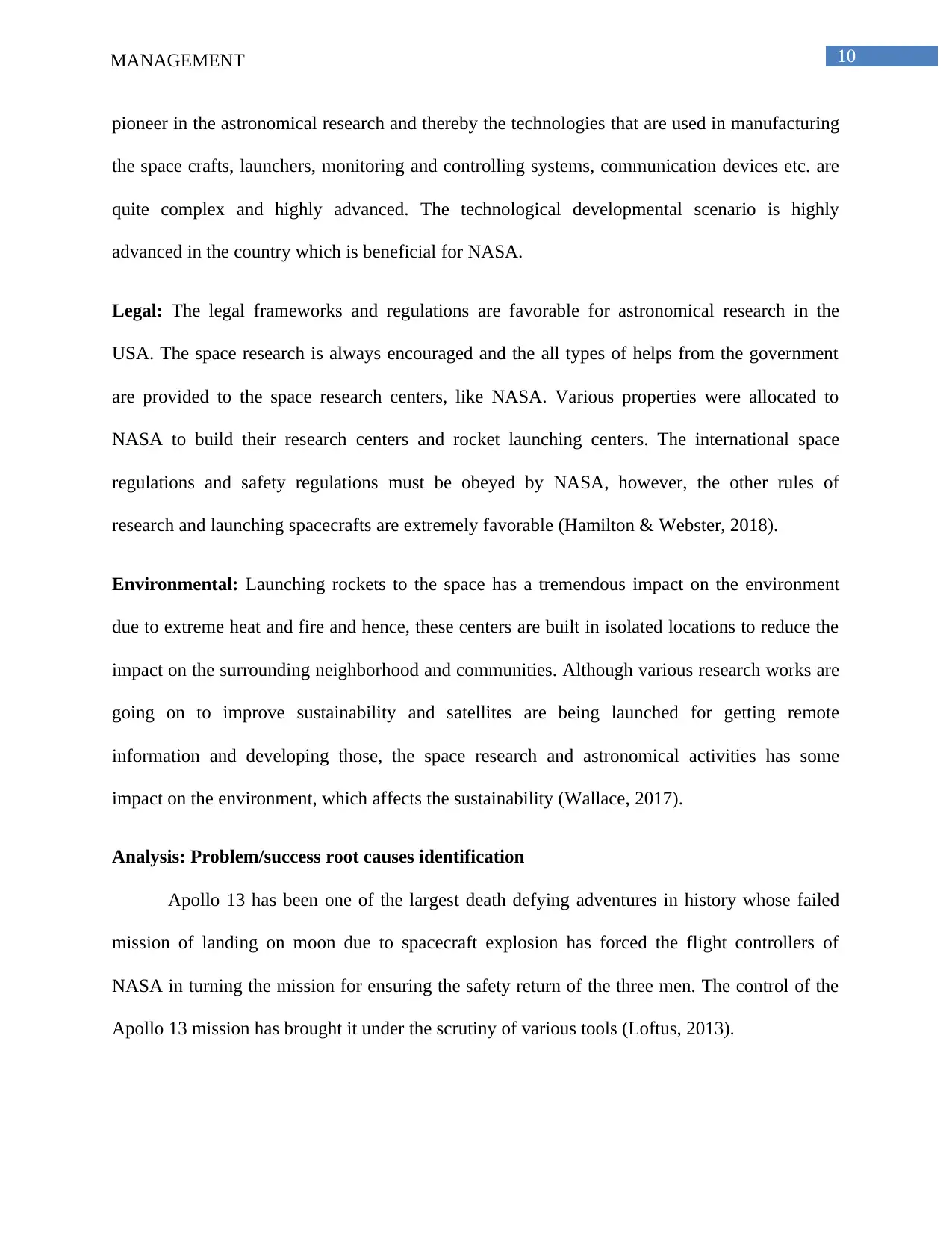
10MANAGEMENT
pioneer in the astronomical research and thereby the technologies that are used in manufacturing
the space crafts, launchers, monitoring and controlling systems, communication devices etc. are
quite complex and highly advanced. The technological developmental scenario is highly
advanced in the country which is beneficial for NASA.
Legal: The legal frameworks and regulations are favorable for astronomical research in the
USA. The space research is always encouraged and the all types of helps from the government
are provided to the space research centers, like NASA. Various properties were allocated to
NASA to build their research centers and rocket launching centers. The international space
regulations and safety regulations must be obeyed by NASA, however, the other rules of
research and launching spacecrafts are extremely favorable (Hamilton & Webster, 2018).
Environmental: Launching rockets to the space has a tremendous impact on the environment
due to extreme heat and fire and hence, these centers are built in isolated locations to reduce the
impact on the surrounding neighborhood and communities. Although various research works are
going on to improve sustainability and satellites are being launched for getting remote
information and developing those, the space research and astronomical activities has some
impact on the environment, which affects the sustainability (Wallace, 2017).
Analysis: Problem/success root causes identification
Apollo 13 has been one of the largest death defying adventures in history whose failed
mission of landing on moon due to spacecraft explosion has forced the flight controllers of
NASA in turning the mission for ensuring the safety return of the three men. The control of the
Apollo 13 mission has brought it under the scrutiny of various tools (Loftus, 2013).
pioneer in the astronomical research and thereby the technologies that are used in manufacturing
the space crafts, launchers, monitoring and controlling systems, communication devices etc. are
quite complex and highly advanced. The technological developmental scenario is highly
advanced in the country which is beneficial for NASA.
Legal: The legal frameworks and regulations are favorable for astronomical research in the
USA. The space research is always encouraged and the all types of helps from the government
are provided to the space research centers, like NASA. Various properties were allocated to
NASA to build their research centers and rocket launching centers. The international space
regulations and safety regulations must be obeyed by NASA, however, the other rules of
research and launching spacecrafts are extremely favorable (Hamilton & Webster, 2018).
Environmental: Launching rockets to the space has a tremendous impact on the environment
due to extreme heat and fire and hence, these centers are built in isolated locations to reduce the
impact on the surrounding neighborhood and communities. Although various research works are
going on to improve sustainability and satellites are being launched for getting remote
information and developing those, the space research and astronomical activities has some
impact on the environment, which affects the sustainability (Wallace, 2017).
Analysis: Problem/success root causes identification
Apollo 13 has been one of the largest death defying adventures in history whose failed
mission of landing on moon due to spacecraft explosion has forced the flight controllers of
NASA in turning the mission for ensuring the safety return of the three men. The control of the
Apollo 13 mission has brought it under the scrutiny of various tools (Loftus, 2013).
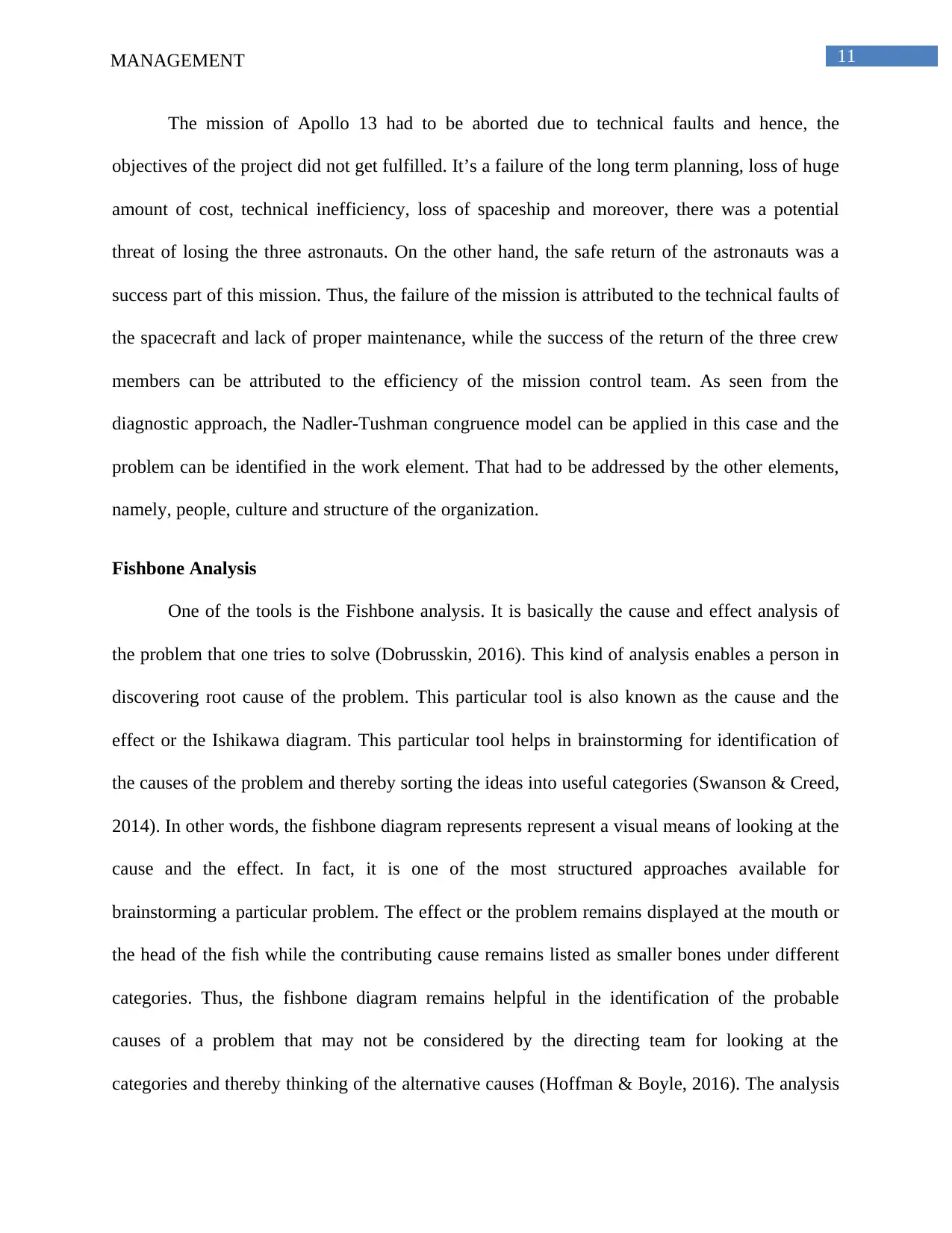
11MANAGEMENT
The mission of Apollo 13 had to be aborted due to technical faults and hence, the
objectives of the project did not get fulfilled. It’s a failure of the long term planning, loss of huge
amount of cost, technical inefficiency, loss of spaceship and moreover, there was a potential
threat of losing the three astronauts. On the other hand, the safe return of the astronauts was a
success part of this mission. Thus, the failure of the mission is attributed to the technical faults of
the spacecraft and lack of proper maintenance, while the success of the return of the three crew
members can be attributed to the efficiency of the mission control team. As seen from the
diagnostic approach, the Nadler-Tushman congruence model can be applied in this case and the
problem can be identified in the work element. That had to be addressed by the other elements,
namely, people, culture and structure of the organization.
Fishbone Analysis
One of the tools is the Fishbone analysis. It is basically the cause and effect analysis of
the problem that one tries to solve (Dobrusskin, 2016). This kind of analysis enables a person in
discovering root cause of the problem. This particular tool is also known as the cause and the
effect or the Ishikawa diagram. This particular tool helps in brainstorming for identification of
the causes of the problem and thereby sorting the ideas into useful categories (Swanson & Creed,
2014). In other words, the fishbone diagram represents represent a visual means of looking at the
cause and the effect. In fact, it is one of the most structured approaches available for
brainstorming a particular problem. The effect or the problem remains displayed at the mouth or
the head of the fish while the contributing cause remains listed as smaller bones under different
categories. Thus, the fishbone diagram remains helpful in the identification of the probable
causes of a problem that may not be considered by the directing team for looking at the
categories and thereby thinking of the alternative causes (Hoffman & Boyle, 2016). The analysis
The mission of Apollo 13 had to be aborted due to technical faults and hence, the
objectives of the project did not get fulfilled. It’s a failure of the long term planning, loss of huge
amount of cost, technical inefficiency, loss of spaceship and moreover, there was a potential
threat of losing the three astronauts. On the other hand, the safe return of the astronauts was a
success part of this mission. Thus, the failure of the mission is attributed to the technical faults of
the spacecraft and lack of proper maintenance, while the success of the return of the three crew
members can be attributed to the efficiency of the mission control team. As seen from the
diagnostic approach, the Nadler-Tushman congruence model can be applied in this case and the
problem can be identified in the work element. That had to be addressed by the other elements,
namely, people, culture and structure of the organization.
Fishbone Analysis
One of the tools is the Fishbone analysis. It is basically the cause and effect analysis of
the problem that one tries to solve (Dobrusskin, 2016). This kind of analysis enables a person in
discovering root cause of the problem. This particular tool is also known as the cause and the
effect or the Ishikawa diagram. This particular tool helps in brainstorming for identification of
the causes of the problem and thereby sorting the ideas into useful categories (Swanson & Creed,
2014). In other words, the fishbone diagram represents represent a visual means of looking at the
cause and the effect. In fact, it is one of the most structured approaches available for
brainstorming a particular problem. The effect or the problem remains displayed at the mouth or
the head of the fish while the contributing cause remains listed as smaller bones under different
categories. Thus, the fishbone diagram remains helpful in the identification of the probable
causes of a problem that may not be considered by the directing team for looking at the
categories and thereby thinking of the alternative causes (Hoffman & Boyle, 2016). The analysis
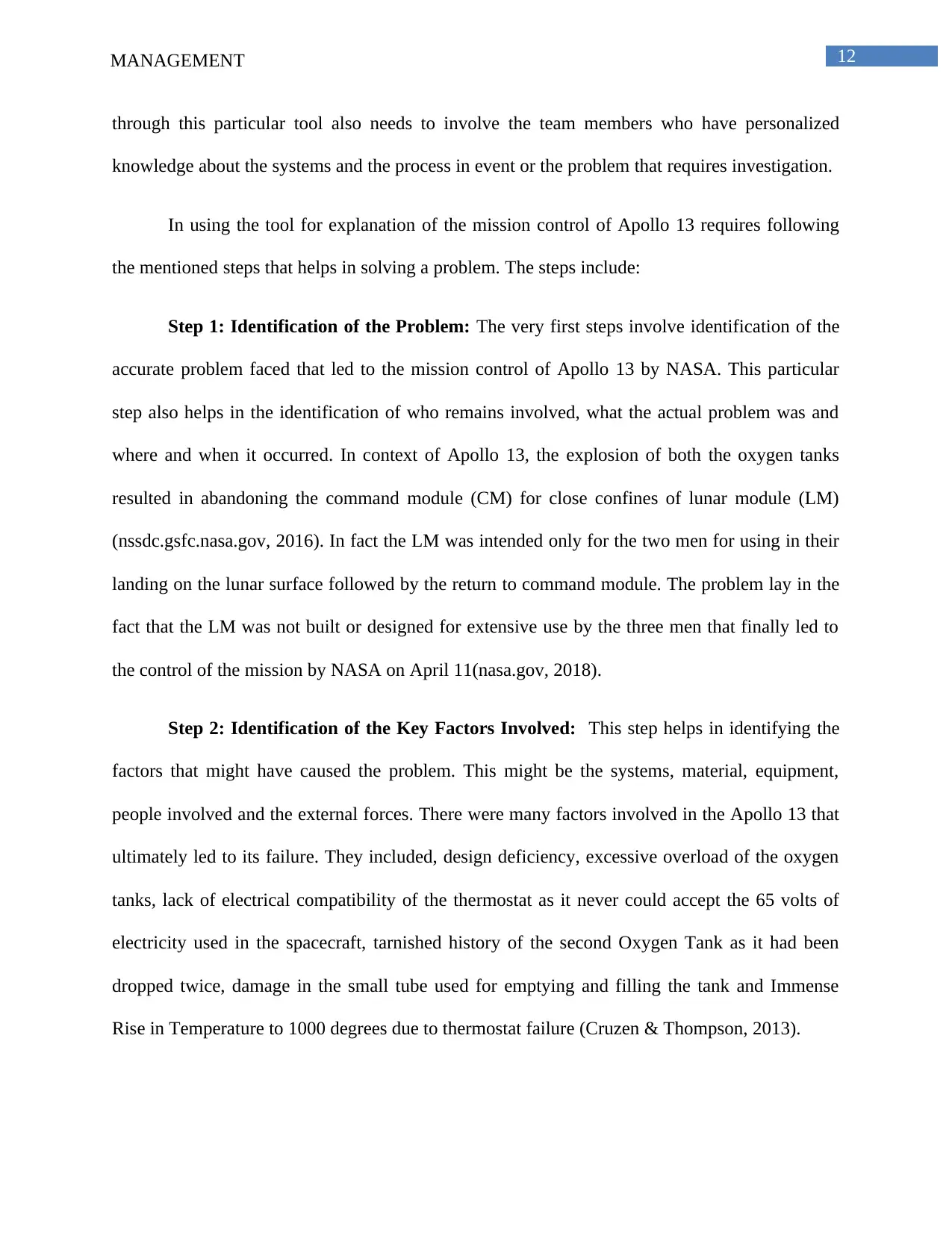
12MANAGEMENT
through this particular tool also needs to involve the team members who have personalized
knowledge about the systems and the process in event or the problem that requires investigation.
In using the tool for explanation of the mission control of Apollo 13 requires following
the mentioned steps that helps in solving a problem. The steps include:
Step 1: Identification of the Problem: The very first steps involve identification of the
accurate problem faced that led to the mission control of Apollo 13 by NASA. This particular
step also helps in the identification of who remains involved, what the actual problem was and
where and when it occurred. In context of Apollo 13, the explosion of both the oxygen tanks
resulted in abandoning the command module (CM) for close confines of lunar module (LM)
(nssdc.gsfc.nasa.gov, 2016). In fact the LM was intended only for the two men for using in their
landing on the lunar surface followed by the return to command module. The problem lay in the
fact that the LM was not built or designed for extensive use by the three men that finally led to
the control of the mission by NASA on April 11(nasa.gov, 2018).
Step 2: Identification of the Key Factors Involved: This step helps in identifying the
factors that might have caused the problem. This might be the systems, material, equipment,
people involved and the external forces. There were many factors involved in the Apollo 13 that
ultimately led to its failure. They included, design deficiency, excessive overload of the oxygen
tanks, lack of electrical compatibility of the thermostat as it never could accept the 65 volts of
electricity used in the spacecraft, tarnished history of the second Oxygen Tank as it had been
dropped twice, damage in the small tube used for emptying and filling the tank and Immense
Rise in Temperature to 1000 degrees due to thermostat failure (Cruzen & Thompson, 2013).
through this particular tool also needs to involve the team members who have personalized
knowledge about the systems and the process in event or the problem that requires investigation.
In using the tool for explanation of the mission control of Apollo 13 requires following
the mentioned steps that helps in solving a problem. The steps include:
Step 1: Identification of the Problem: The very first steps involve identification of the
accurate problem faced that led to the mission control of Apollo 13 by NASA. This particular
step also helps in the identification of who remains involved, what the actual problem was and
where and when it occurred. In context of Apollo 13, the explosion of both the oxygen tanks
resulted in abandoning the command module (CM) for close confines of lunar module (LM)
(nssdc.gsfc.nasa.gov, 2016). In fact the LM was intended only for the two men for using in their
landing on the lunar surface followed by the return to command module. The problem lay in the
fact that the LM was not built or designed for extensive use by the three men that finally led to
the control of the mission by NASA on April 11(nasa.gov, 2018).
Step 2: Identification of the Key Factors Involved: This step helps in identifying the
factors that might have caused the problem. This might be the systems, material, equipment,
people involved and the external forces. There were many factors involved in the Apollo 13 that
ultimately led to its failure. They included, design deficiency, excessive overload of the oxygen
tanks, lack of electrical compatibility of the thermostat as it never could accept the 65 volts of
electricity used in the spacecraft, tarnished history of the second Oxygen Tank as it had been
dropped twice, damage in the small tube used for emptying and filling the tank and Immense
Rise in Temperature to 1000 degrees due to thermostat failure (Cruzen & Thompson, 2013).
Paraphrase This Document
Need a fresh take? Get an instant paraphrase of this document with our AI Paraphraser
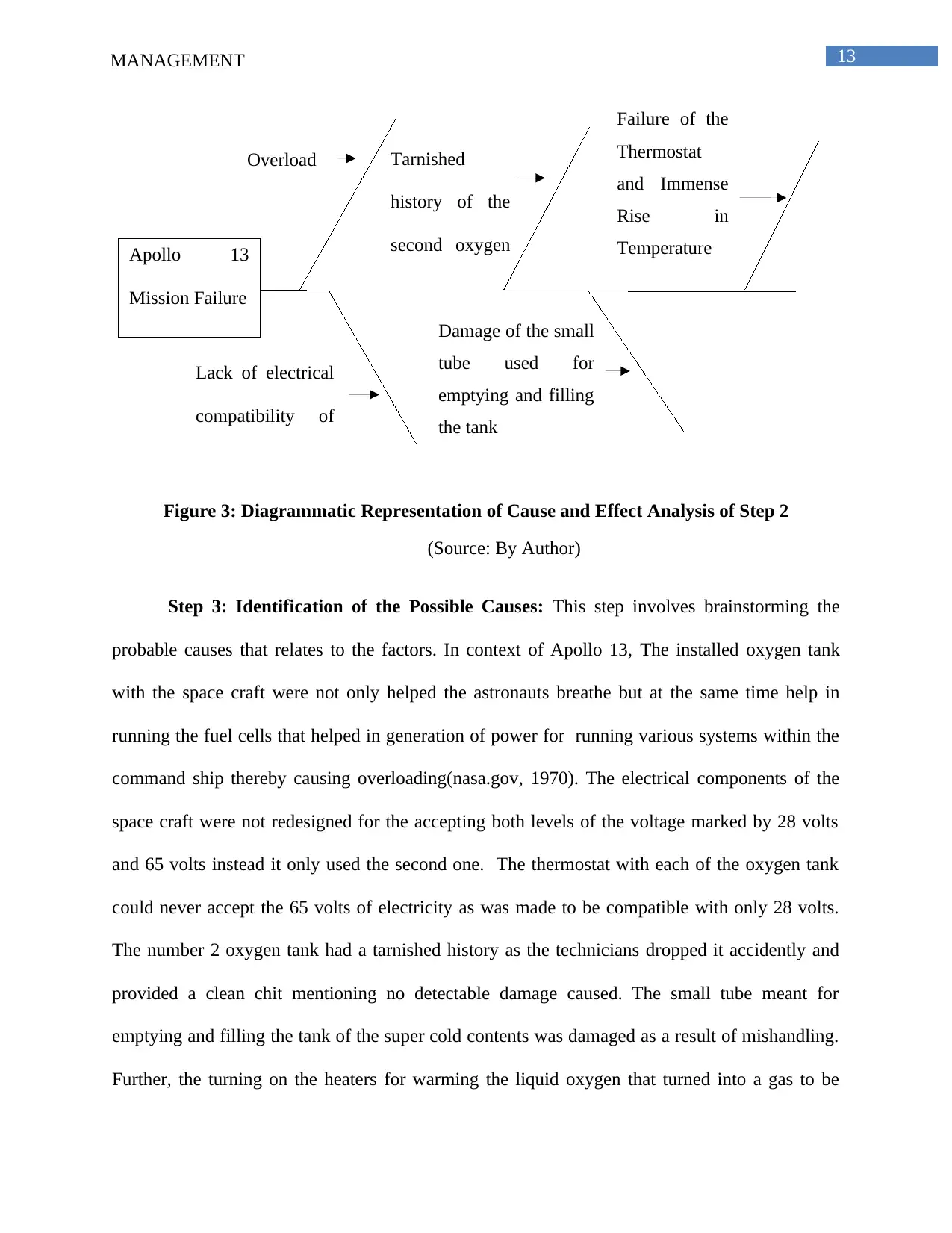
13MANAGEMENT
Figure 3: Diagrammatic Representation of Cause and Effect Analysis of Step 2
(Source: By Author)
Step 3: Identification of the Possible Causes: This step involves brainstorming the
probable causes that relates to the factors. In context of Apollo 13, The installed oxygen tank
with the space craft were not only helped the astronauts breathe but at the same time help in
running the fuel cells that helped in generation of power for running various systems within the
command ship thereby causing overloading(nasa.gov, 1970). The electrical components of the
space craft were not redesigned for the accepting both levels of the voltage marked by 28 volts
and 65 volts instead it only used the second one. The thermostat with each of the oxygen tank
could never accept the 65 volts of electricity as was made to be compatible with only 28 volts.
The number 2 oxygen tank had a tarnished history as the technicians dropped it accidently and
provided a clean chit mentioning no detectable damage caused. The small tube meant for
emptying and filling the tank of the super cold contents was damaged as a result of mishandling.
Further, the turning on the heaters for warming the liquid oxygen that turned into a gas to be
Apollo 13
Mission Failure
Overload
Lack of electrical
compatibility of
thermostat
Tarnished
history of the
second oxygen
tank
Damage of the small
tube used for
emptying and filling
the tank
Failure of the
Thermostat
and Immense
Rise in
Temperature
Figure 3: Diagrammatic Representation of Cause and Effect Analysis of Step 2
(Source: By Author)
Step 3: Identification of the Possible Causes: This step involves brainstorming the
probable causes that relates to the factors. In context of Apollo 13, The installed oxygen tank
with the space craft were not only helped the astronauts breathe but at the same time help in
running the fuel cells that helped in generation of power for running various systems within the
command ship thereby causing overloading(nasa.gov, 1970). The electrical components of the
space craft were not redesigned for the accepting both levels of the voltage marked by 28 volts
and 65 volts instead it only used the second one. The thermostat with each of the oxygen tank
could never accept the 65 volts of electricity as was made to be compatible with only 28 volts.
The number 2 oxygen tank had a tarnished history as the technicians dropped it accidently and
provided a clean chit mentioning no detectable damage caused. The small tube meant for
emptying and filling the tank of the super cold contents was damaged as a result of mishandling.
Further, the turning on the heaters for warming the liquid oxygen that turned into a gas to be
Apollo 13
Mission Failure
Overload
Lack of electrical
compatibility of
thermostat
Tarnished
history of the
second oxygen
tank
Damage of the small
tube used for
emptying and filling
the tank
Failure of the
Thermostat
and Immense
Rise in
Temperature
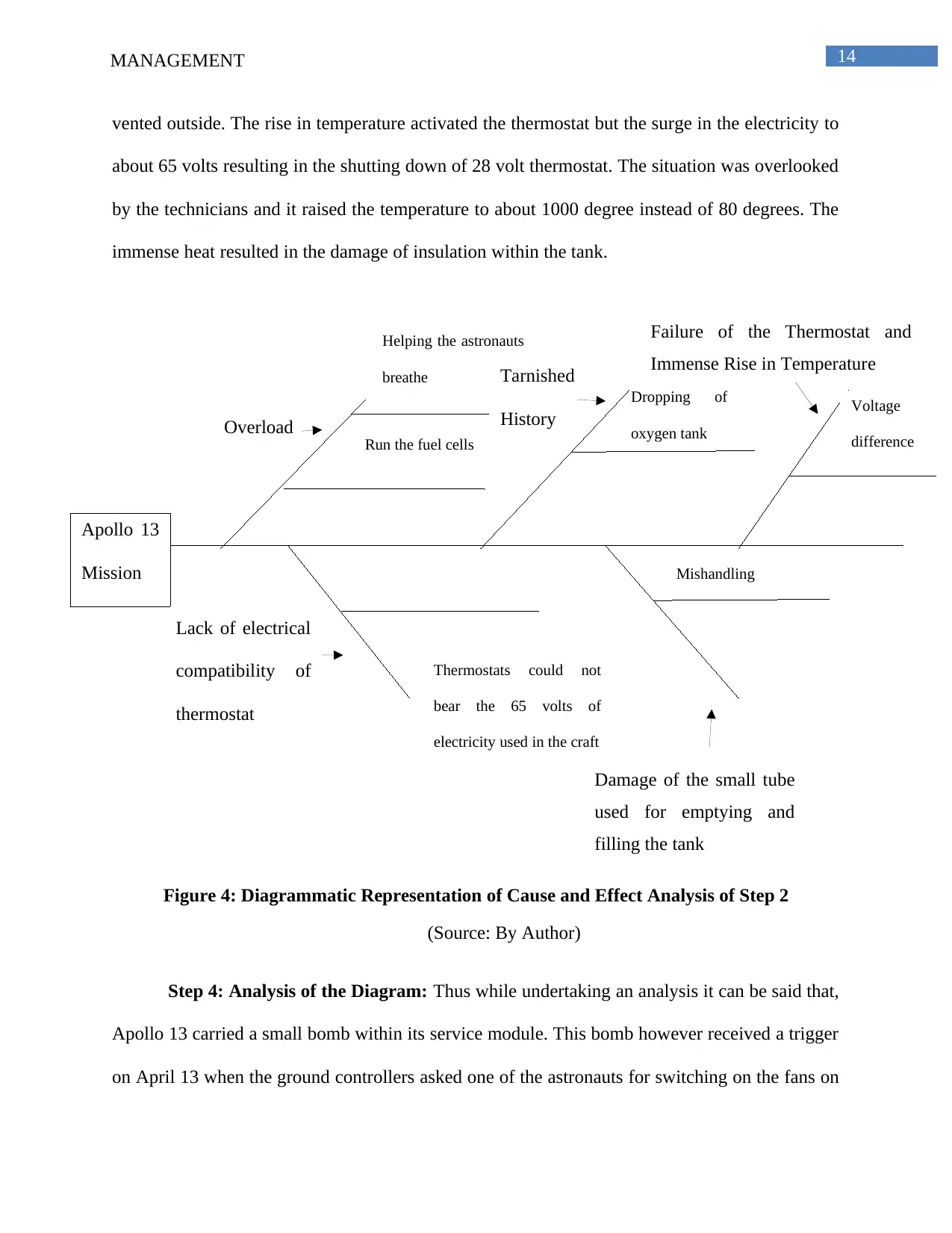
14MANAGEMENT
vented outside. The rise in temperature activated the thermostat but the surge in the electricity to
about 65 volts resulting in the shutting down of 28 volt thermostat. The situation was overlooked
by the technicians and it raised the temperature to about 1000 degree instead of 80 degrees. The
immense heat resulted in the damage of insulation within the tank.
Overload
Figure 4: Diagrammatic Representation of Cause and Effect Analysis of Step 2
(Source: By Author)
Step 4: Analysis of the Diagram: Thus while undertaking an analysis it can be said that,
Apollo 13 carried a small bomb within its service module. This bomb however received a trigger
on April 13 when the ground controllers asked one of the astronauts for switching on the fans on
Apollo 13
Mission
Failure
Helping the astronauts
breathe
Run the fuel cells
Lack of electrical
compatibility of
thermostat
Thermostats could not
bear the 65 volts of
electricity used in the craft
Tarnished
History
Dropping of
oxygen tank
Damage of the small tube
used for emptying and
filling the tank
Mishandling
Failure of the Thermostat and
Immense Rise in Temperature
Voltage
difference
vented outside. The rise in temperature activated the thermostat but the surge in the electricity to
about 65 volts resulting in the shutting down of 28 volt thermostat. The situation was overlooked
by the technicians and it raised the temperature to about 1000 degree instead of 80 degrees. The
immense heat resulted in the damage of insulation within the tank.
Overload
Figure 4: Diagrammatic Representation of Cause and Effect Analysis of Step 2
(Source: By Author)
Step 4: Analysis of the Diagram: Thus while undertaking an analysis it can be said that,
Apollo 13 carried a small bomb within its service module. This bomb however received a trigger
on April 13 when the ground controllers asked one of the astronauts for switching on the fans on
Apollo 13
Mission
Failure
Helping the astronauts
breathe
Run the fuel cells
Lack of electrical
compatibility of
thermostat
Thermostats could not
bear the 65 volts of
electricity used in the craft
Tarnished
History
Dropping of
oxygen tank
Damage of the small tube
used for emptying and
filling the tank
Mishandling
Failure of the Thermostat and
Immense Rise in Temperature
Voltage
difference
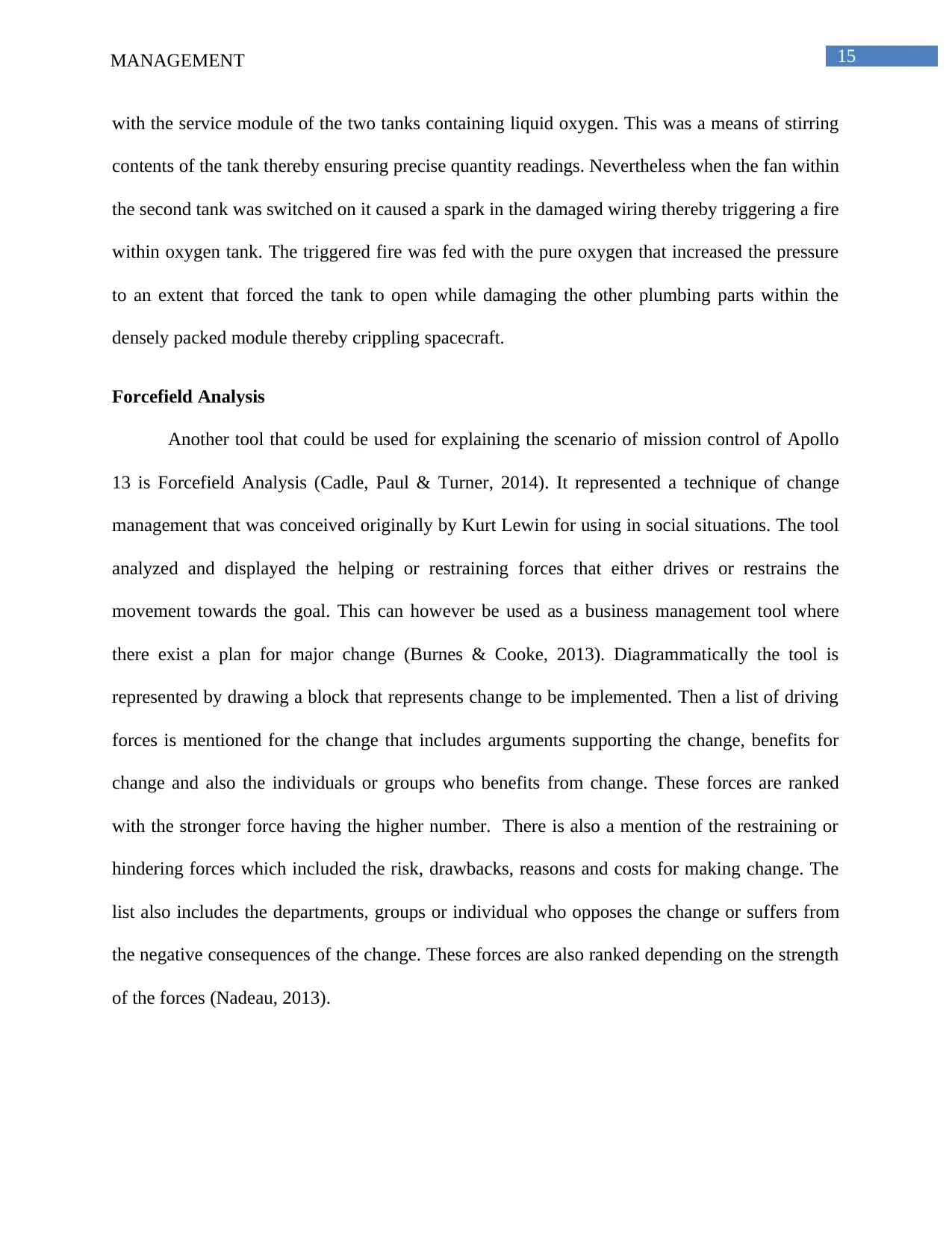
15MANAGEMENT
with the service module of the two tanks containing liquid oxygen. This was a means of stirring
contents of the tank thereby ensuring precise quantity readings. Nevertheless when the fan within
the second tank was switched on it caused a spark in the damaged wiring thereby triggering a fire
within oxygen tank. The triggered fire was fed with the pure oxygen that increased the pressure
to an extent that forced the tank to open while damaging the other plumbing parts within the
densely packed module thereby crippling spacecraft.
Forcefield Analysis
Another tool that could be used for explaining the scenario of mission control of Apollo
13 is Forcefield Analysis (Cadle, Paul & Turner, 2014). It represented a technique of change
management that was conceived originally by Kurt Lewin for using in social situations. The tool
analyzed and displayed the helping or restraining forces that either drives or restrains the
movement towards the goal. This can however be used as a business management tool where
there exist a plan for major change (Burnes & Cooke, 2013). Diagrammatically the tool is
represented by drawing a block that represents change to be implemented. Then a list of driving
forces is mentioned for the change that includes arguments supporting the change, benefits for
change and also the individuals or groups who benefits from change. These forces are ranked
with the stronger force having the higher number. There is also a mention of the restraining or
hindering forces which included the risk, drawbacks, reasons and costs for making change. The
list also includes the departments, groups or individual who opposes the change or suffers from
the negative consequences of the change. These forces are also ranked depending on the strength
of the forces (Nadeau, 2013).
with the service module of the two tanks containing liquid oxygen. This was a means of stirring
contents of the tank thereby ensuring precise quantity readings. Nevertheless when the fan within
the second tank was switched on it caused a spark in the damaged wiring thereby triggering a fire
within oxygen tank. The triggered fire was fed with the pure oxygen that increased the pressure
to an extent that forced the tank to open while damaging the other plumbing parts within the
densely packed module thereby crippling spacecraft.
Forcefield Analysis
Another tool that could be used for explaining the scenario of mission control of Apollo
13 is Forcefield Analysis (Cadle, Paul & Turner, 2014). It represented a technique of change
management that was conceived originally by Kurt Lewin for using in social situations. The tool
analyzed and displayed the helping or restraining forces that either drives or restrains the
movement towards the goal. This can however be used as a business management tool where
there exist a plan for major change (Burnes & Cooke, 2013). Diagrammatically the tool is
represented by drawing a block that represents change to be implemented. Then a list of driving
forces is mentioned for the change that includes arguments supporting the change, benefits for
change and also the individuals or groups who benefits from change. These forces are ranked
with the stronger force having the higher number. There is also a mention of the restraining or
hindering forces which included the risk, drawbacks, reasons and costs for making change. The
list also includes the departments, groups or individual who opposes the change or suffers from
the negative consequences of the change. These forces are also ranked depending on the strength
of the forces (Nadeau, 2013).
Secure Best Marks with AI Grader
Need help grading? Try our AI Grader for instant feedback on your assignments.
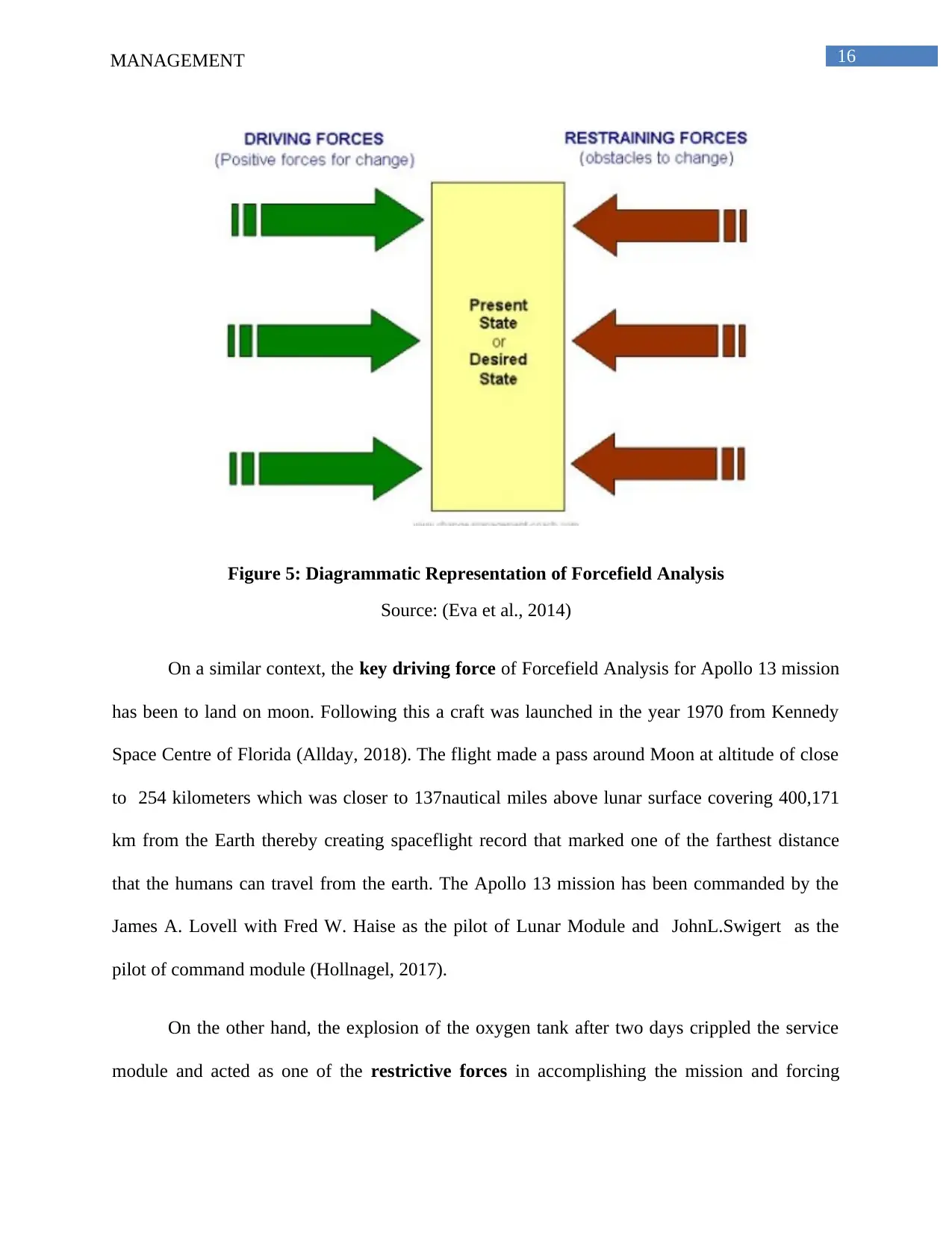
16MANAGEMENT
Figure 5: Diagrammatic Representation of Forcefield Analysis
Source: (Eva et al., 2014)
On a similar context, the key driving force of Forcefield Analysis for Apollo 13 mission
has been to land on moon. Following this a craft was launched in the year 1970 from Kennedy
Space Centre of Florida (Allday, 2018). The flight made a pass around Moon at altitude of close
to 254 kilometers which was closer to 137nautical miles above lunar surface covering 400,171
km from the Earth thereby creating spaceflight record that marked one of the farthest distance
that the humans can travel from the earth. The Apollo 13 mission has been commanded by the
James A. Lovell with Fred W. Haise as the pilot of Lunar Module and JohnL.Swigert as the
pilot of command module (Hollnagel, 2017).
On the other hand, the explosion of the oxygen tank after two days crippled the service
module and acted as one of the restrictive forces in accomplishing the mission and forcing
Figure 5: Diagrammatic Representation of Forcefield Analysis
Source: (Eva et al., 2014)
On a similar context, the key driving force of Forcefield Analysis for Apollo 13 mission
has been to land on moon. Following this a craft was launched in the year 1970 from Kennedy
Space Centre of Florida (Allday, 2018). The flight made a pass around Moon at altitude of close
to 254 kilometers which was closer to 137nautical miles above lunar surface covering 400,171
km from the Earth thereby creating spaceflight record that marked one of the farthest distance
that the humans can travel from the earth. The Apollo 13 mission has been commanded by the
James A. Lovell with Fred W. Haise as the pilot of Lunar Module and JohnL.Swigert as the
pilot of command module (Hollnagel, 2017).
On the other hand, the explosion of the oxygen tank after two days crippled the service
module and acted as one of the restrictive forces in accomplishing the mission and forcing
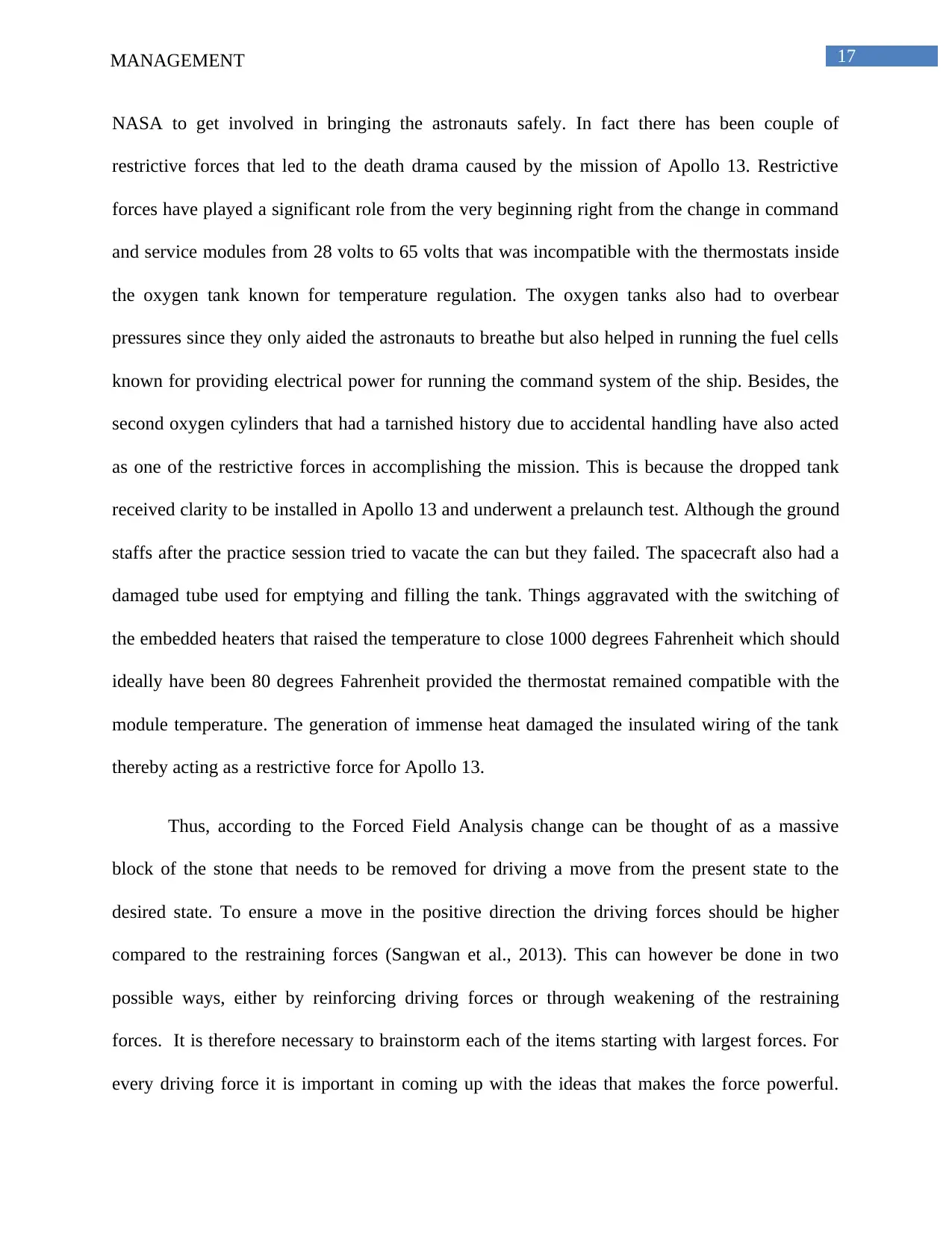
17MANAGEMENT
NASA to get involved in bringing the astronauts safely. In fact there has been couple of
restrictive forces that led to the death drama caused by the mission of Apollo 13. Restrictive
forces have played a significant role from the very beginning right from the change in command
and service modules from 28 volts to 65 volts that was incompatible with the thermostats inside
the oxygen tank known for temperature regulation. The oxygen tanks also had to overbear
pressures since they only aided the astronauts to breathe but also helped in running the fuel cells
known for providing electrical power for running the command system of the ship. Besides, the
second oxygen cylinders that had a tarnished history due to accidental handling have also acted
as one of the restrictive forces in accomplishing the mission. This is because the dropped tank
received clarity to be installed in Apollo 13 and underwent a prelaunch test. Although the ground
staffs after the practice session tried to vacate the can but they failed. The spacecraft also had a
damaged tube used for emptying and filling the tank. Things aggravated with the switching of
the embedded heaters that raised the temperature to close 1000 degrees Fahrenheit which should
ideally have been 80 degrees Fahrenheit provided the thermostat remained compatible with the
module temperature. The generation of immense heat damaged the insulated wiring of the tank
thereby acting as a restrictive force for Apollo 13.
Thus, according to the Forced Field Analysis change can be thought of as a massive
block of the stone that needs to be removed for driving a move from the present state to the
desired state. To ensure a move in the positive direction the driving forces should be higher
compared to the restraining forces (Sangwan et al., 2013). This can however be done in two
possible ways, either by reinforcing driving forces or through weakening of the restraining
forces. It is therefore necessary to brainstorm each of the items starting with largest forces. For
every driving force it is important in coming up with the ideas that makes the force powerful.
NASA to get involved in bringing the astronauts safely. In fact there has been couple of
restrictive forces that led to the death drama caused by the mission of Apollo 13. Restrictive
forces have played a significant role from the very beginning right from the change in command
and service modules from 28 volts to 65 volts that was incompatible with the thermostats inside
the oxygen tank known for temperature regulation. The oxygen tanks also had to overbear
pressures since they only aided the astronauts to breathe but also helped in running the fuel cells
known for providing electrical power for running the command system of the ship. Besides, the
second oxygen cylinders that had a tarnished history due to accidental handling have also acted
as one of the restrictive forces in accomplishing the mission. This is because the dropped tank
received clarity to be installed in Apollo 13 and underwent a prelaunch test. Although the ground
staffs after the practice session tried to vacate the can but they failed. The spacecraft also had a
damaged tube used for emptying and filling the tank. Things aggravated with the switching of
the embedded heaters that raised the temperature to close 1000 degrees Fahrenheit which should
ideally have been 80 degrees Fahrenheit provided the thermostat remained compatible with the
module temperature. The generation of immense heat damaged the insulated wiring of the tank
thereby acting as a restrictive force for Apollo 13.
Thus, according to the Forced Field Analysis change can be thought of as a massive
block of the stone that needs to be removed for driving a move from the present state to the
desired state. To ensure a move in the positive direction the driving forces should be higher
compared to the restraining forces (Sangwan et al., 2013). This can however be done in two
possible ways, either by reinforcing driving forces or through weakening of the restraining
forces. It is therefore necessary to brainstorm each of the items starting with largest forces. For
every driving force it is important in coming up with the ideas that makes the force powerful.
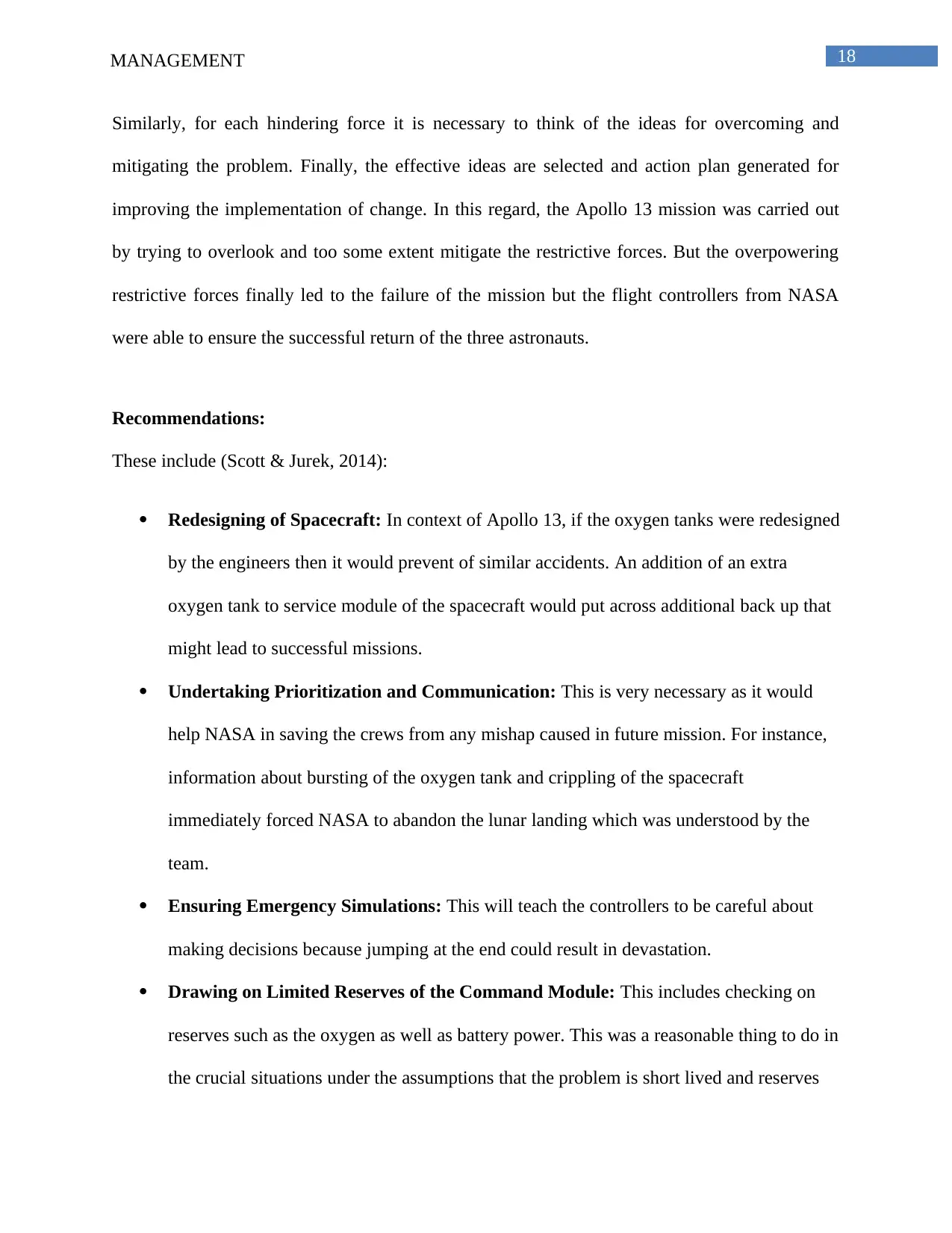
18MANAGEMENT
Similarly, for each hindering force it is necessary to think of the ideas for overcoming and
mitigating the problem. Finally, the effective ideas are selected and action plan generated for
improving the implementation of change. In this regard, the Apollo 13 mission was carried out
by trying to overlook and too some extent mitigate the restrictive forces. But the overpowering
restrictive forces finally led to the failure of the mission but the flight controllers from NASA
were able to ensure the successful return of the three astronauts.
Recommendations:
These include (Scott & Jurek, 2014):
Redesigning of Spacecraft: In context of Apollo 13, if the oxygen tanks were redesigned
by the engineers then it would prevent of similar accidents. An addition of an extra
oxygen tank to service module of the spacecraft would put across additional back up that
might lead to successful missions.
Undertaking Prioritization and Communication: This is very necessary as it would
help NASA in saving the crews from any mishap caused in future mission. For instance,
information about bursting of the oxygen tank and crippling of the spacecraft
immediately forced NASA to abandon the lunar landing which was understood by the
team.
Ensuring Emergency Simulations: This will teach the controllers to be careful about
making decisions because jumping at the end could result in devastation.
Drawing on Limited Reserves of the Command Module: This includes checking on
reserves such as the oxygen as well as battery power. This was a reasonable thing to do in
the crucial situations under the assumptions that the problem is short lived and reserves
Similarly, for each hindering force it is necessary to think of the ideas for overcoming and
mitigating the problem. Finally, the effective ideas are selected and action plan generated for
improving the implementation of change. In this regard, the Apollo 13 mission was carried out
by trying to overlook and too some extent mitigate the restrictive forces. But the overpowering
restrictive forces finally led to the failure of the mission but the flight controllers from NASA
were able to ensure the successful return of the three astronauts.
Recommendations:
These include (Scott & Jurek, 2014):
Redesigning of Spacecraft: In context of Apollo 13, if the oxygen tanks were redesigned
by the engineers then it would prevent of similar accidents. An addition of an extra
oxygen tank to service module of the spacecraft would put across additional back up that
might lead to successful missions.
Undertaking Prioritization and Communication: This is very necessary as it would
help NASA in saving the crews from any mishap caused in future mission. For instance,
information about bursting of the oxygen tank and crippling of the spacecraft
immediately forced NASA to abandon the lunar landing which was understood by the
team.
Ensuring Emergency Simulations: This will teach the controllers to be careful about
making decisions because jumping at the end could result in devastation.
Drawing on Limited Reserves of the Command Module: This includes checking on
reserves such as the oxygen as well as battery power. This was a reasonable thing to do in
the crucial situations under the assumptions that the problem is short lived and reserves
Paraphrase This Document
Need a fresh take? Get an instant paraphrase of this document with our AI Paraphraser
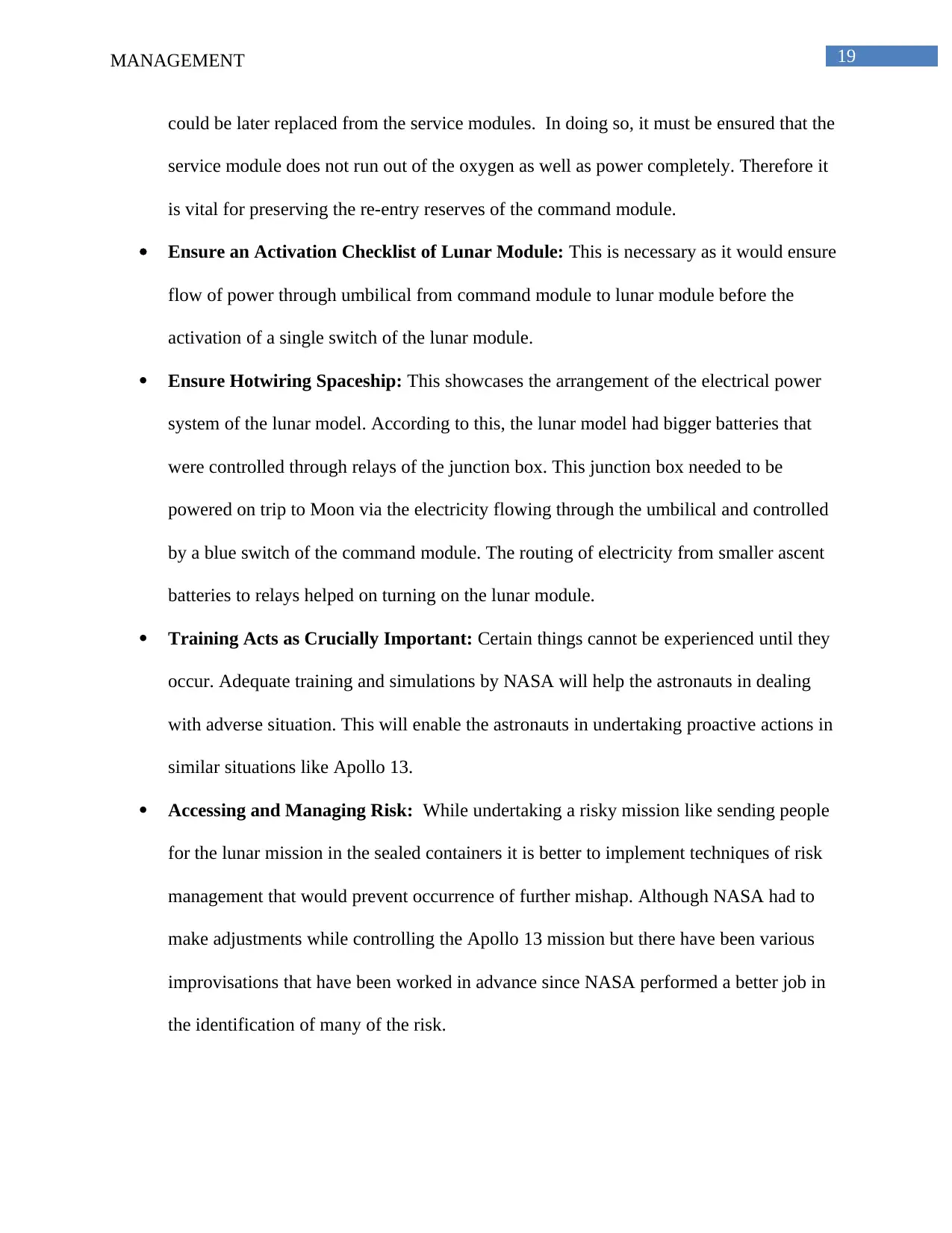
19MANAGEMENT
could be later replaced from the service modules. In doing so, it must be ensured that the
service module does not run out of the oxygen as well as power completely. Therefore it
is vital for preserving the re-entry reserves of the command module.
Ensure an Activation Checklist of Lunar Module: This is necessary as it would ensure
flow of power through umbilical from command module to lunar module before the
activation of a single switch of the lunar module.
Ensure Hotwiring Spaceship: This showcases the arrangement of the electrical power
system of the lunar model. According to this, the lunar model had bigger batteries that
were controlled through relays of the junction box. This junction box needed to be
powered on trip to Moon via the electricity flowing through the umbilical and controlled
by a blue switch of the command module. The routing of electricity from smaller ascent
batteries to relays helped on turning on the lunar module.
Training Acts as Crucially Important: Certain things cannot be experienced until they
occur. Adequate training and simulations by NASA will help the astronauts in dealing
with adverse situation. This will enable the astronauts in undertaking proactive actions in
similar situations like Apollo 13.
Accessing and Managing Risk: While undertaking a risky mission like sending people
for the lunar mission in the sealed containers it is better to implement techniques of risk
management that would prevent occurrence of further mishap. Although NASA had to
make adjustments while controlling the Apollo 13 mission but there have been various
improvisations that have been worked in advance since NASA performed a better job in
the identification of many of the risk.
could be later replaced from the service modules. In doing so, it must be ensured that the
service module does not run out of the oxygen as well as power completely. Therefore it
is vital for preserving the re-entry reserves of the command module.
Ensure an Activation Checklist of Lunar Module: This is necessary as it would ensure
flow of power through umbilical from command module to lunar module before the
activation of a single switch of the lunar module.
Ensure Hotwiring Spaceship: This showcases the arrangement of the electrical power
system of the lunar model. According to this, the lunar model had bigger batteries that
were controlled through relays of the junction box. This junction box needed to be
powered on trip to Moon via the electricity flowing through the umbilical and controlled
by a blue switch of the command module. The routing of electricity from smaller ascent
batteries to relays helped on turning on the lunar module.
Training Acts as Crucially Important: Certain things cannot be experienced until they
occur. Adequate training and simulations by NASA will help the astronauts in dealing
with adverse situation. This will enable the astronauts in undertaking proactive actions in
similar situations like Apollo 13.
Accessing and Managing Risk: While undertaking a risky mission like sending people
for the lunar mission in the sealed containers it is better to implement techniques of risk
management that would prevent occurrence of further mishap. Although NASA had to
make adjustments while controlling the Apollo 13 mission but there have been various
improvisations that have been worked in advance since NASA performed a better job in
the identification of many of the risk.
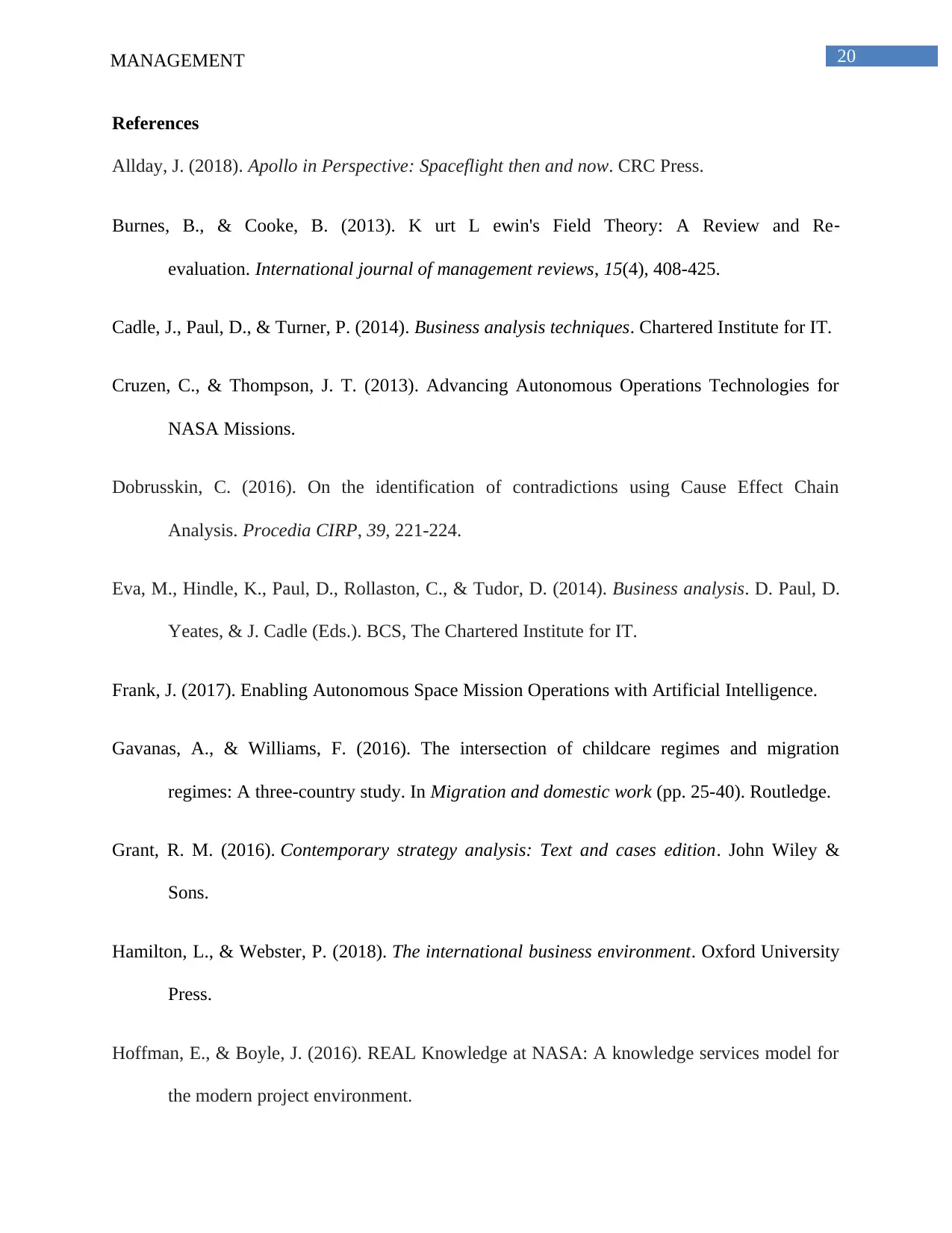
20MANAGEMENT
References
Allday, J. (2018). Apollo in Perspective: Spaceflight then and now. CRC Press.
Burnes, B., & Cooke, B. (2013). K urt L ewin's Field Theory: A Review and Re‐
evaluation. International journal of management reviews, 15(4), 408-425.
Cadle, J., Paul, D., & Turner, P. (2014). Business analysis techniques. Chartered Institute for IT.
Cruzen, C., & Thompson, J. T. (2013). Advancing Autonomous Operations Technologies for
NASA Missions.
Dobrusskin, C. (2016). On the identification of contradictions using Cause Effect Chain
Analysis. Procedia CIRP, 39, 221-224.
Eva, M., Hindle, K., Paul, D., Rollaston, C., & Tudor, D. (2014). Business analysis. D. Paul, D.
Yeates, & J. Cadle (Eds.). BCS, The Chartered Institute for IT.
Frank, J. (2017). Enabling Autonomous Space Mission Operations with Artificial Intelligence.
Gavanas, A., & Williams, F. (2016). The intersection of childcare regimes and migration
regimes: A three-country study. In Migration and domestic work (pp. 25-40). Routledge.
Grant, R. M. (2016). Contemporary strategy analysis: Text and cases edition. John Wiley &
Sons.
Hamilton, L., & Webster, P. (2018). The international business environment. Oxford University
Press.
Hoffman, E., & Boyle, J. (2016). REAL Knowledge at NASA: A knowledge services model for
the modern project environment.
References
Allday, J. (2018). Apollo in Perspective: Spaceflight then and now. CRC Press.
Burnes, B., & Cooke, B. (2013). K urt L ewin's Field Theory: A Review and Re‐
evaluation. International journal of management reviews, 15(4), 408-425.
Cadle, J., Paul, D., & Turner, P. (2014). Business analysis techniques. Chartered Institute for IT.
Cruzen, C., & Thompson, J. T. (2013). Advancing Autonomous Operations Technologies for
NASA Missions.
Dobrusskin, C. (2016). On the identification of contradictions using Cause Effect Chain
Analysis. Procedia CIRP, 39, 221-224.
Eva, M., Hindle, K., Paul, D., Rollaston, C., & Tudor, D. (2014). Business analysis. D. Paul, D.
Yeates, & J. Cadle (Eds.). BCS, The Chartered Institute for IT.
Frank, J. (2017). Enabling Autonomous Space Mission Operations with Artificial Intelligence.
Gavanas, A., & Williams, F. (2016). The intersection of childcare regimes and migration
regimes: A three-country study. In Migration and domestic work (pp. 25-40). Routledge.
Grant, R. M. (2016). Contemporary strategy analysis: Text and cases edition. John Wiley &
Sons.
Hamilton, L., & Webster, P. (2018). The international business environment. Oxford University
Press.
Hoffman, E., & Boyle, J. (2016). REAL Knowledge at NASA: A knowledge services model for
the modern project environment.
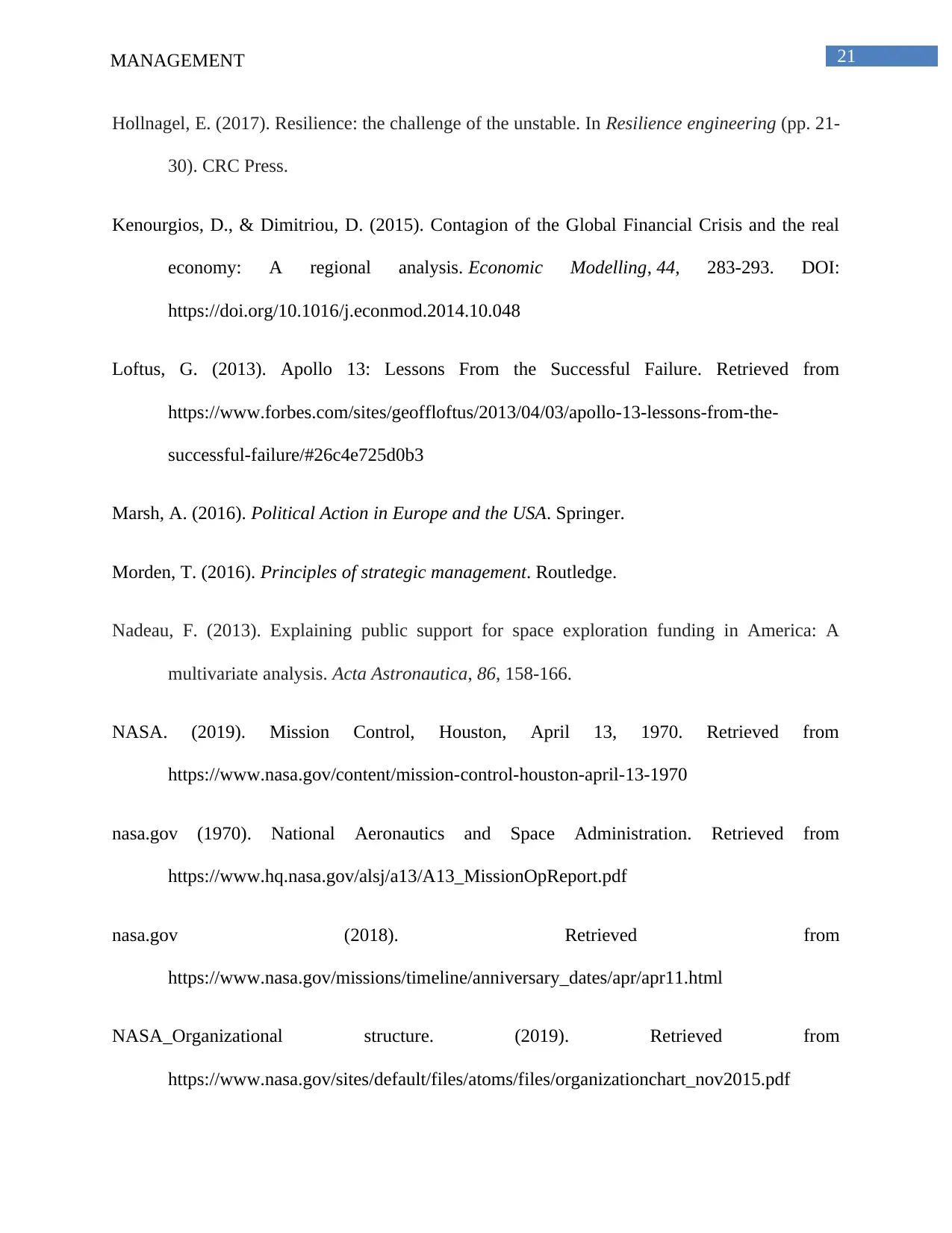
21MANAGEMENT
Hollnagel, E. (2017). Resilience: the challenge of the unstable. In Resilience engineering (pp. 21-
30). CRC Press.
Kenourgios, D., & Dimitriou, D. (2015). Contagion of the Global Financial Crisis and the real
economy: A regional analysis. Economic Modelling, 44, 283-293. DOI:
https://doi.org/10.1016/j.econmod.2014.10.048
Loftus, G. (2013). Apollo 13: Lessons From the Successful Failure. Retrieved from
https://www.forbes.com/sites/geoffloftus/2013/04/03/apollo-13-lessons-from-the-
successful-failure/#26c4e725d0b3
Marsh, A. (2016). Political Action in Europe and the USA. Springer.
Morden, T. (2016). Principles of strategic management. Routledge.
Nadeau, F. (2013). Explaining public support for space exploration funding in America: A
multivariate analysis. Acta Astronautica, 86, 158-166.
NASA. (2019). Mission Control, Houston, April 13, 1970. Retrieved from
https://www.nasa.gov/content/mission-control-houston-april-13-1970
nasa.gov (1970). National Aeronautics and Space Administration. Retrieved from
https://www.hq.nasa.gov/alsj/a13/A13_MissionOpReport.pdf
nasa.gov (2018). Retrieved from
https://www.nasa.gov/missions/timeline/anniversary_dates/apr/apr11.html
NASA_Organizational structure. (2019). Retrieved from
https://www.nasa.gov/sites/default/files/atoms/files/organizationchart_nov2015.pdf
Hollnagel, E. (2017). Resilience: the challenge of the unstable. In Resilience engineering (pp. 21-
30). CRC Press.
Kenourgios, D., & Dimitriou, D. (2015). Contagion of the Global Financial Crisis and the real
economy: A regional analysis. Economic Modelling, 44, 283-293. DOI:
https://doi.org/10.1016/j.econmod.2014.10.048
Loftus, G. (2013). Apollo 13: Lessons From the Successful Failure. Retrieved from
https://www.forbes.com/sites/geoffloftus/2013/04/03/apollo-13-lessons-from-the-
successful-failure/#26c4e725d0b3
Marsh, A. (2016). Political Action in Europe and the USA. Springer.
Morden, T. (2016). Principles of strategic management. Routledge.
Nadeau, F. (2013). Explaining public support for space exploration funding in America: A
multivariate analysis. Acta Astronautica, 86, 158-166.
NASA. (2019). Mission Control, Houston, April 13, 1970. Retrieved from
https://www.nasa.gov/content/mission-control-houston-april-13-1970
nasa.gov (1970). National Aeronautics and Space Administration. Retrieved from
https://www.hq.nasa.gov/alsj/a13/A13_MissionOpReport.pdf
nasa.gov (2018). Retrieved from
https://www.nasa.gov/missions/timeline/anniversary_dates/apr/apr11.html
NASA_Organizational structure. (2019). Retrieved from
https://www.nasa.gov/sites/default/files/atoms/files/organizationchart_nov2015.pdf
Secure Best Marks with AI Grader
Need help grading? Try our AI Grader for instant feedback on your assignments.
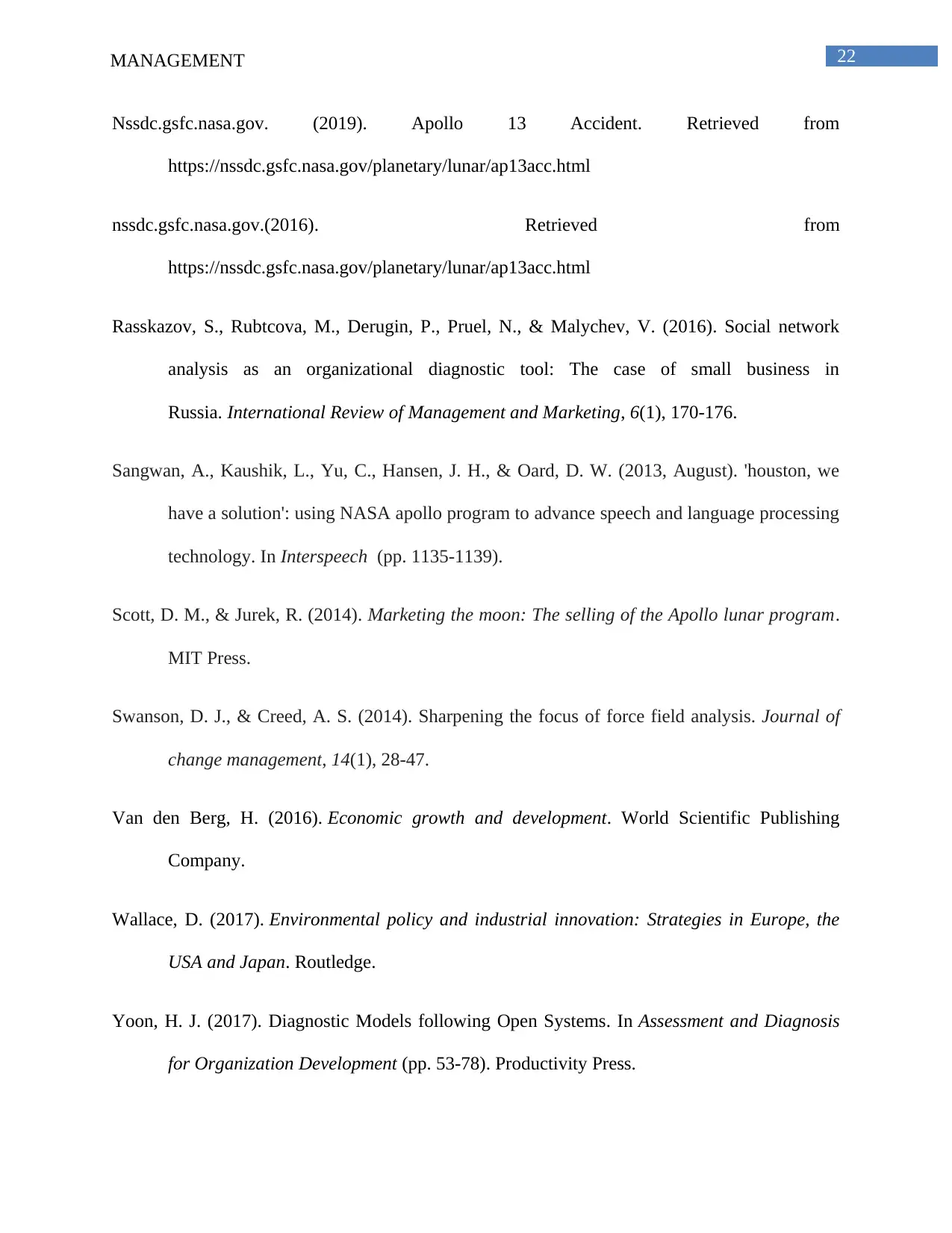
22MANAGEMENT
Nssdc.gsfc.nasa.gov. (2019). Apollo 13 Accident. Retrieved from
https://nssdc.gsfc.nasa.gov/planetary/lunar/ap13acc.html
nssdc.gsfc.nasa.gov.(2016). Retrieved from
https://nssdc.gsfc.nasa.gov/planetary/lunar/ap13acc.html
Rasskazov, S., Rubtcova, M., Derugin, P., Pruel, N., & Malychev, V. (2016). Social network
analysis as an organizational diagnostic tool: The case of small business in
Russia. International Review of Management and Marketing, 6(1), 170-176.
Sangwan, A., Kaushik, L., Yu, C., Hansen, J. H., & Oard, D. W. (2013, August). 'houston, we
have a solution': using NASA apollo program to advance speech and language processing
technology. In Interspeech (pp. 1135-1139).
Scott, D. M., & Jurek, R. (2014). Marketing the moon: The selling of the Apollo lunar program.
MIT Press.
Swanson, D. J., & Creed, A. S. (2014). Sharpening the focus of force field analysis. Journal of
change management, 14(1), 28-47.
Van den Berg, H. (2016). Economic growth and development. World Scientific Publishing
Company.
Wallace, D. (2017). Environmental policy and industrial innovation: Strategies in Europe, the
USA and Japan. Routledge.
Yoon, H. J. (2017). Diagnostic Models following Open Systems. In Assessment and Diagnosis
for Organization Development (pp. 53-78). Productivity Press.
Nssdc.gsfc.nasa.gov. (2019). Apollo 13 Accident. Retrieved from
https://nssdc.gsfc.nasa.gov/planetary/lunar/ap13acc.html
nssdc.gsfc.nasa.gov.(2016). Retrieved from
https://nssdc.gsfc.nasa.gov/planetary/lunar/ap13acc.html
Rasskazov, S., Rubtcova, M., Derugin, P., Pruel, N., & Malychev, V. (2016). Social network
analysis as an organizational diagnostic tool: The case of small business in
Russia. International Review of Management and Marketing, 6(1), 170-176.
Sangwan, A., Kaushik, L., Yu, C., Hansen, J. H., & Oard, D. W. (2013, August). 'houston, we
have a solution': using NASA apollo program to advance speech and language processing
technology. In Interspeech (pp. 1135-1139).
Scott, D. M., & Jurek, R. (2014). Marketing the moon: The selling of the Apollo lunar program.
MIT Press.
Swanson, D. J., & Creed, A. S. (2014). Sharpening the focus of force field analysis. Journal of
change management, 14(1), 28-47.
Van den Berg, H. (2016). Economic growth and development. World Scientific Publishing
Company.
Wallace, D. (2017). Environmental policy and industrial innovation: Strategies in Europe, the
USA and Japan. Routledge.
Yoon, H. J. (2017). Diagnostic Models following Open Systems. In Assessment and Diagnosis
for Organization Development (pp. 53-78). Productivity Press.
1 out of 23
Your All-in-One AI-Powered Toolkit for Academic Success.
+13062052269
info@desklib.com
Available 24*7 on WhatsApp / Email
![[object Object]](/_next/static/media/star-bottom.7253800d.svg)
Unlock your academic potential
© 2024 | Zucol Services PVT LTD | All rights reserved.